SAMSUNG LN-T1954H User Manual [fr]
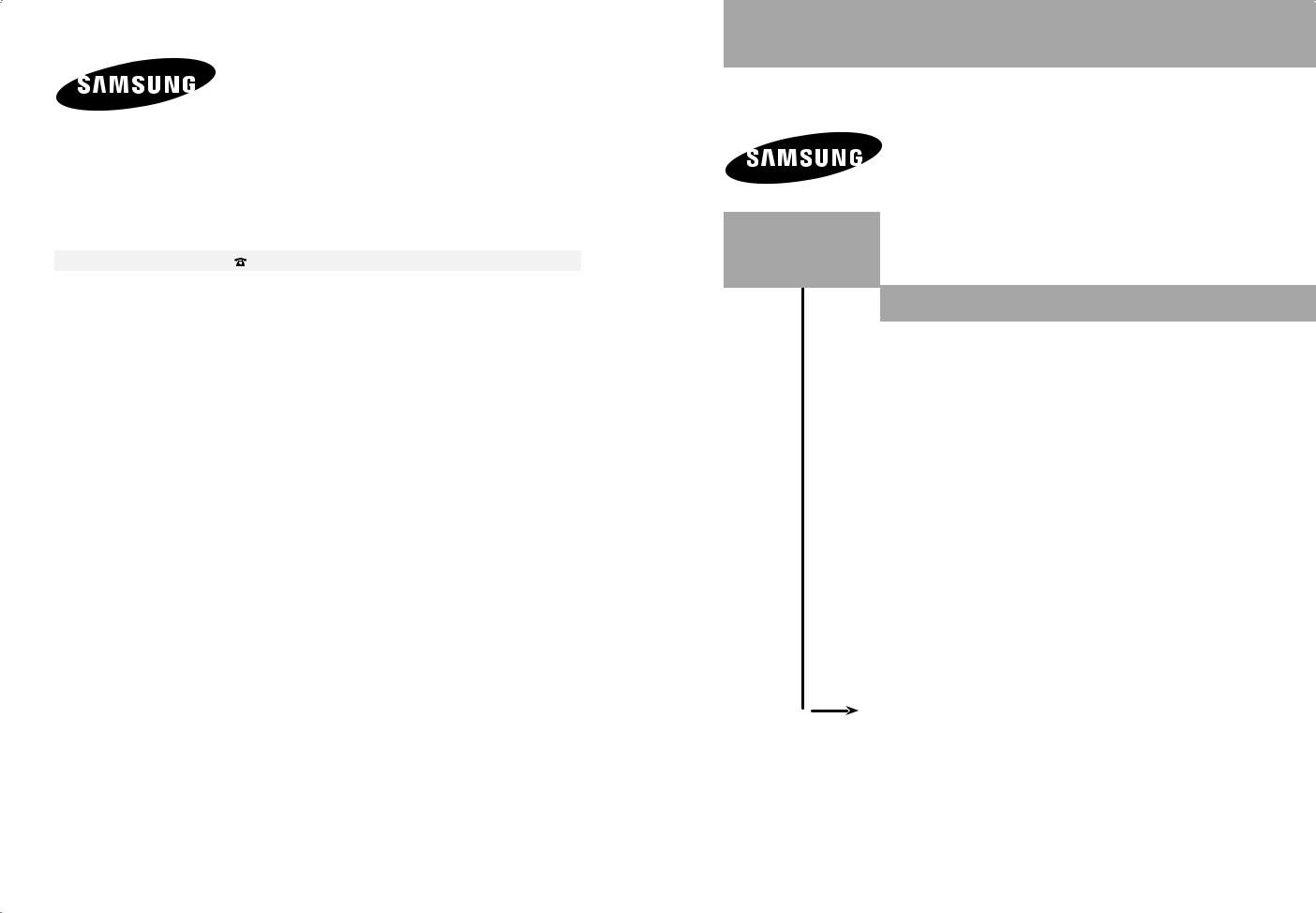
Contact SAMSUNG WORLD-WIDE
If you have any questions or comments relating to Samsung products, please contact the SAMSUNG customer care center.
Contacte con SAMSUNG WORLD-WIDE
Si tiene alguna pregunta o comentario referente a nuestros productos, por favor contacte con nuestro Servicio de Atención al Cliente.
Country |
Customer Care Center |
Web Site |
Address |
|
|
|
|
Samsung Electronics Canada Inc., Customer |
|
|
|
|
Service 55 Standish Court Mississauga, |
|
CANADA |
1-800-SAMSUNG (7267864) |
www.samsung.com/ca |
Ontario L5R 4B2 Canada |
|
Samsung Electronique Canada Inc., |
||||
|
|
|
||
|
|
|
Service à la Clientèle 55 Standish Court |
|
|
|
|
Mississauga, Ontario L5R 4B2 Canada |
|
|
|
|
Samsung Electronics America, Inc. |
|
U.S.A |
1-800-SAMSUNG (7267864) |
www.samsung.com |
105 Challenger Road |
|
|
|
|
Ridgefield Park, NJ 07660-0511 |
LN-T1953H
LN-T1954H
TFT-LCD TELEVISION
|
Owner’s |
|
Instructions |
|
Register your product at www.samsung.com/global/register |
|
Record your Model and Serial number here for future reference. |
BN68-01184A-00 |
· Model __________ · Serial No. ____________ |

Precautions When Displaying a Still Image
A still image may cause permanent damage to the TV screen
•Do not display a still image on the LCD panel for more than 2 hours as it can cause screen image retention. This image retention is also known as "screen burn".
To avoid such image retention, reduce the degree of brightness and contrast of the screen when displaying a still image.
•Watching the LCD TV in 4:3 format for a long period of time may leave traces of borders displayed on the left, right and center of the screen caused by the difference of light emission on the screen.
Playing a DVD or a game console may cause a similar effect to the screen.
Damages caused by the above effect are not covered by the Warranty.
•Displaying still images from Video games and PC for longer than a certain period of time may produce partial after-images.
To prevent this effect, reduce the ‘brightness’ and ‘contrast’ when displaying still images.
Précautions à prendre lors de l’affichage d’une image fixe
Une image fixe peut causer des dommages irrémédiables à l’écran du téléviseur.
•N’affichez pas une image fixe sur l’écran LCD plus de 2 heures. Cela pourrait provoquer une rémanence de l’image à l’écran. Cette rémanence de l’image est également appelée “brûlure de l’écran”. Pour éviter une telle rémanence de l’image à l’écran, réduisez la luminosité et le contraste de l’écran lorsque vous laissez une image fixe affichée
•Regarder l’écran LCD du téléviseur en format 4:3 pendant une longue période peut laisser des traces de bordures à gauche, à droite et au centre de l’écran, à cause de la différence d’émission de lumière sur l’écran.
La lecture d’un DVD ou l’utilisation d’une console de jeu peut avoir un effet similaire sur l’écran. Les dommages provoqués par les effets qui précèdent ne sont pas couverts par la garantie.
•L’affichage d’images fixes de jeux vidéo et d’ordinateurs pendant plus longtemps qu’une période spécifique peut provoquer des rémanences.Pour éviter cela, réduisez la “luminosité” et le “contraste” lors de l’affichage d’images fixes.
©2007 Samsung Electronics Co., Ltd. All rights reserved.

Contents |
|
General Information |
|
■ List of Features................................................................. |
2 |
■ Accessories....................................................................... |
2 |
■ Viewing the Control Panel ................................................ |
3 |
■ Viewing the Connection Panel ......................................... |
4 |
■ Remote Control................................................................. |
5 |
■ Installing Batteries in the Remote Control......................... |
6 |
Connections |
|
■ Connecting VHF and UHF Antennas................................ |
6 |
■ Connecting Cable TV........................................................ |
7 |
■ Connecting a VCR............................................................ |
8 |
■ Connecting a DVD Player/Set-Top Box............................. |
9 |
■ Connecting a DVD Player/Set-Top Box via HDMI............. |
9 |
■ Connecting a DVD Player/Set-Top Box via DVI.............. |
10 |
■ Connecting a Digital Audio System................................. |
10 |
■ Connecting a PC.............................................................. |
11 |
Operation |
|
■ Turning the TV On and Off.............................................. |
12 |
■ Plug & Play Feature........................................................ |
12 |
■ Changing Channels......................................................... |
13 |
■ Adjusting the Volume...................................................... |
14 |
■ Viewing the Display......................................................... |
14 |
■ Viewing the Menus.......................................................... |
15 |
■ Memorizing the Channels............................................... |
15 |
■ To Select the Source....................................................... |
17 |
■ To Edit the Input Source Name....................................... |
17 |
Picture Control |
|
■ Using Automatic Picture Settings.................................... |
18 |
■ Adjusting the Color Tone................................................. |
19 |
■ Setting the Film Mode..................................................... |
19 |
■ Freezing the Picture (depending on the model).............. |
19 |
■ Changing the Screen Size.............................................. |
20 |
■ Viewing Picture-in-Picture............................................... |
21 |
■ HDMI Black Level............................................................ |
22 |
Sound Control |
|
■ Customizing the Sound................................................... |
23 |
■ Using Automatic Sound Settings..................................... |
23 |
■ Setting the TruSurround XT............................................ |
24 |
■Choosing a Multi-Channel Sound (MTS) track - Digital . 24
■Choosing a Multi-Channel Sound (MTS) track - Analog 25
■ Automatic Volume Control............................................... |
25 |
■ Selecting the Internal Mute............................................. |
26 |
■ Listening to the Sound of the Sub (PIP) Picture.............. |
26 |
■ Resetting the Sound Settings to the Factory Defaults.... |
27 |
■ Connecting Headphones................................................. |
27 |
■ Setting the On/Off Melody............................................... |
27 |
Channel Control |
|
■ Selecting the Antenna..................................................... |
28 |
■ Clearing Scrambled Channels - Digital........................... |
28 |
■ Setting the Channel Lists................................................ |
29 |
■ To set-up Your Favorite Channels................................... |
30 |
■ Using the Channel Lists.................................................. |
31 |
■ Viewing the Channel Lists............................................... |
31 |
■ Labeling Channels.......................................................... |
32 |
■ LNA(Low Noise Amplifier).............................................. |
32 |
■ Fine Tuning Analog Channels......................................... |
33 |
■ Checking the Digital-Signal Strength.............................. |
33 |
PC Display |
|
■ Using Your TV as a Computer (PC) Display................... |
34 |
■ Display Modes................................................................. |
34 |
■ Setting up the TV with your PC....................................... |
35 |
Time Setting |
|
■ Setting the Clock............................................................. |
37 |
Function Description |
|
■ Selecting a Menu Language........................................... |
40 |
■ Using the Game Mode.................................................... |
40 |
■ Menu Transparency Level............................................... |
40 |
■ Viewing Closed Captions (On-Screen Text Messages) |
|
- Analog........................................................................... |
41 |
■ Viewing Closed Captions (On-Screen Text Messages) |
|
- Digital............................................................................ |
42 |
■ Setting the Function Help................................................ |
43 |
■ Setting the Light Effect.................................................... |
43 |
■ Using the V-Chip............................................................. |
44 |
■ Digital Noise Reduction................................................... |
51 |
■ Upgrading the Software.................................................. |
51 |
Appendix |
|
■ Appendix......................................................................... |
52 |
■ Troubleshooting............................................................... |
52 |
■ Installing the Stand.......................................................... |
54 |
■ Disconnecting the Stand................................................. |
54 |
■ How to Adjust the Stand.................................................. |
55 |
■ Using the Decoration Covers.......................................... |
55 |
■ Installing VESA compliant mounting devices.................. |
55 |
■ Installing the Wall Mount Kit............................................ |
55 |
■ How to Adjust the Angle of the TV................................... |
55 |
■ Using the Anti-Theft Kensington Lock............................. |
56 |
■ Specifications.................................................................. |
56 |
English
Symbol |
Press |
Important |
Note |
One-Touch |
|
|
|
|
Button |
English - |
|
|
|
|
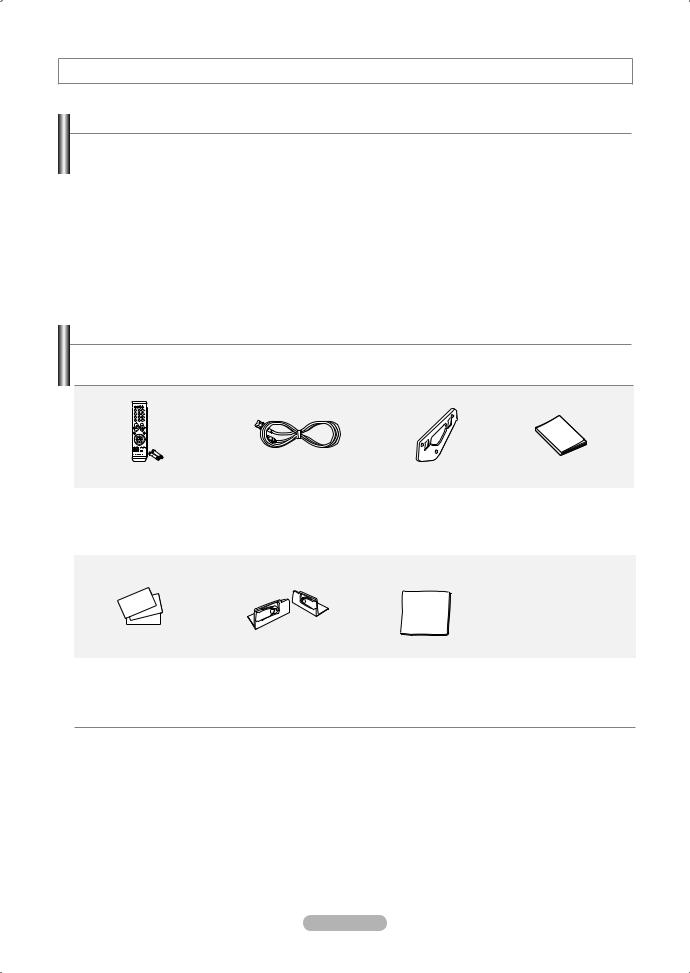
General Information
List of Features
Adjustable picture settings that can be stored in the TV’s memory.
Automatic timer to turn the TV on and off.
A special sleep timer.
V-Chip function.
Excellent Digital Interface & Networking :
With a built-in HD digital tuner, non-subscription HD broadcasts can be viewed with no Set-Top Box needed.
Remote Control
The supplied remote can be used to operate the TV as well as most DVD players, Set-top boxes, Cable Boxes and VCRs.
SRS TruSurround XT
- SRS TruSurround XT provides a virtual Dolby surround system.
Accessories
Please make sure the following items are included with your LCD TV.
If any items are missing, contact your dealer.
Remote Control & Batteries (AAA x 2) ( LN-T1953H:BN59-00601A) LN-T1954H:BN59-00608A
Warranty Card / Registration
Card / Safety Guide Manual
(Not available in all locations)
Power Cord (3903-000085)
Decoration Cover
LN-T1953H-Left: BN63-03216A,
Right: BN63-03217A
LN-T1954H-Left: BN63-03216B,
Right: BN63-03217B
Wall Mount kit |
Owner’s Instructions |
|
(BN96-04960A) |
||
|
Cleaning Cloth
(BN63-01798A)
 The items color and shape may vary depending on the model.
The items color and shape may vary depending on the model.
English -
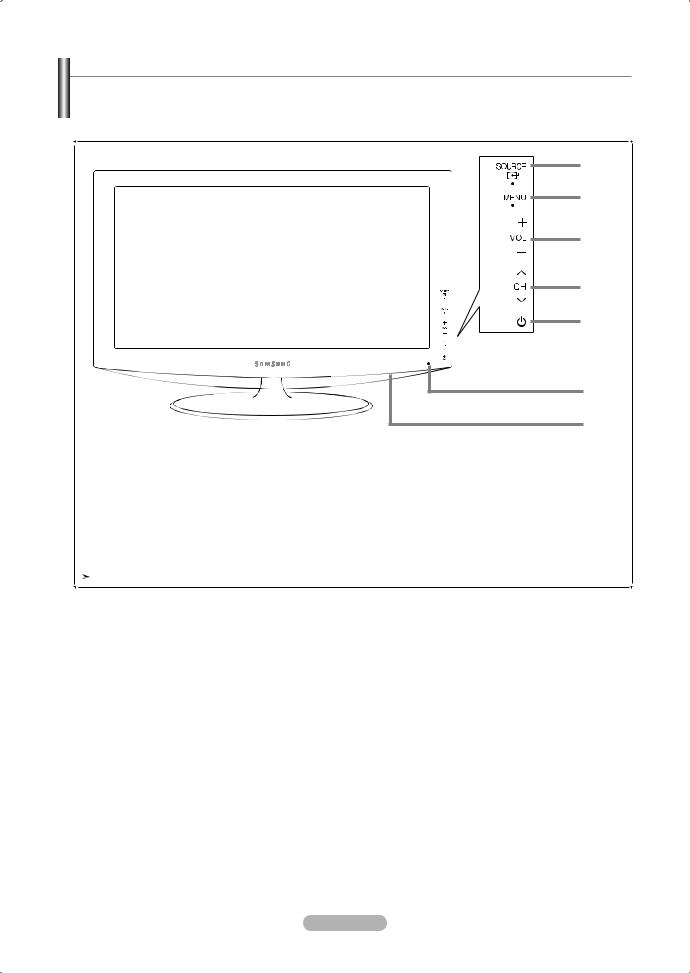
Viewing the Control Panel
Buttons on the Lower Part of the Panel
The buttons on the side panel control your TV’s basic features, including the on-screen menu. To use the more advanced features, you must use the remote control.
1
2
3
4
5
6
7
Front Panel buttons
Touch the right side of each button to operate.
The product color and shape may vary depending on the model.
1SOURCE
Toggles between all the available input sources (TV, AV, S-Video, Component, PC, HDMI).
In the on-screen menu, use this button as you would use the ENTER button on the remote control.
2MENU
Press to see an on-screen menu of your TV’s features.
3+ VOL -
Press to increase or decrease the volume.
In the on-screen menu, use the + VOL - buttons as you would use the ◄ and ► buttons on the remote control.
4 CH
CH 
Press to change channels.
In the on-screen menu, use the  CH
CH  buttons as you would use the ▲ and ▼ butons on the remote control.
buttons as you would use the ▲ and ▼ butons on the remote control.
5 (Power)
(Power)
Press to turn the TV on and off.
POWER INDICATOR
Blinks and turns off when the power is on and lights up in stand-by mode.
6Remote Control Sensor
Aim the remote control towards this spot on the TV.
7SPEAKERS
English -
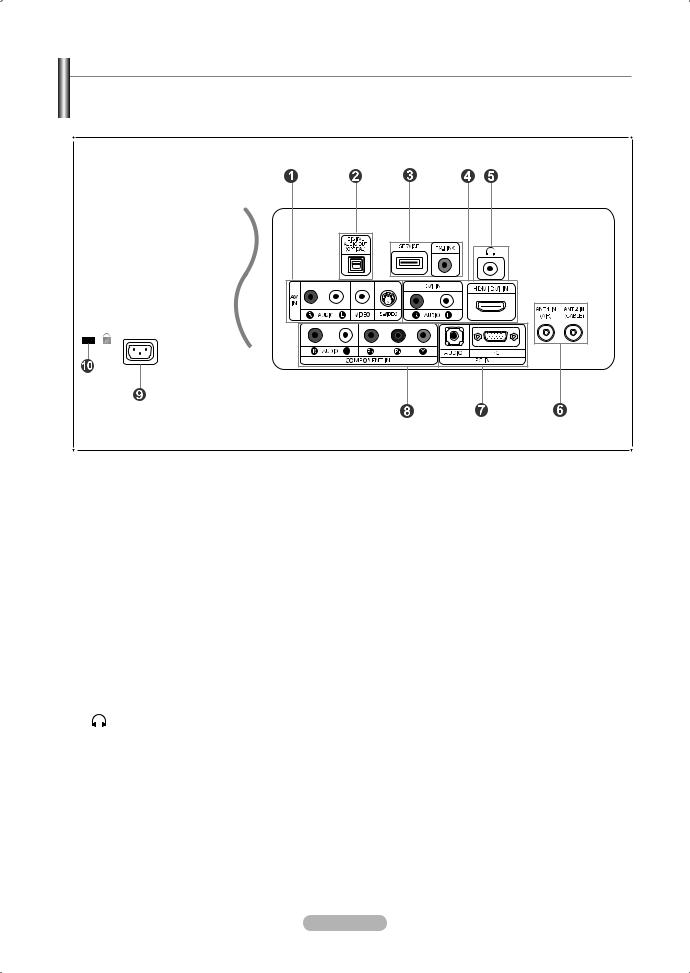
Viewing the Connection Panel
Rear Panel Jacks
Use the rear panel jacks to connect A/V components that will be connected continuously, such as VCR or DVD players. For more information on connecting equipment, see pages 7-11.
1 AV IN
Video and audio inputs for external devices, such as a camcorder or VCR.
S-VIDEO
Connect an S-Video signal from a camcorder or VCR.
2DIGITAL AUDIO OUT (OPTICAL)
Connects to a Digital Audio component.
3SERVICE / EX-LINK
Connector for service only.
4HDMI/DVI IN / DVI IN (AUDIO R/L)
Connect to the HDMI jack of a device with an HDMI output. Use the HDMI/DVI IN terminal for DVI connection to an external device. You should use the DVI to HDMI cable or DVI-HDMI adapter (DVI to HDMI) for video connection, and the DVI IN ‘R-AUDIO-L’ terminal for audio.
HDMI/DVI IN terminal does not support PC.
No sound connection is needed for an HDMI to HDMI connection
5HEADPHONE
Connects a set of external headphones for private listening.
6 ANT 1 IN/ANT 2 IN
Connects to an antenna or cable TV system.
7 PC IN
Connects to the video and audio output jacks on your PC.
8 COMPONENT IN
Connects Component video/audio.
9 POWER INPUT
Connects the supplied power cord.
0 KENSINGTON LOCK
The Kensington lock (not supplied) is a device used to physically fix the system when used in a public place. If you want to use a locking device, contact the dealer where you purchased the TV.
 The place of the Kensington Lock may be different depending on its model.
The place of the Kensington Lock may be different depending on its model.
English -
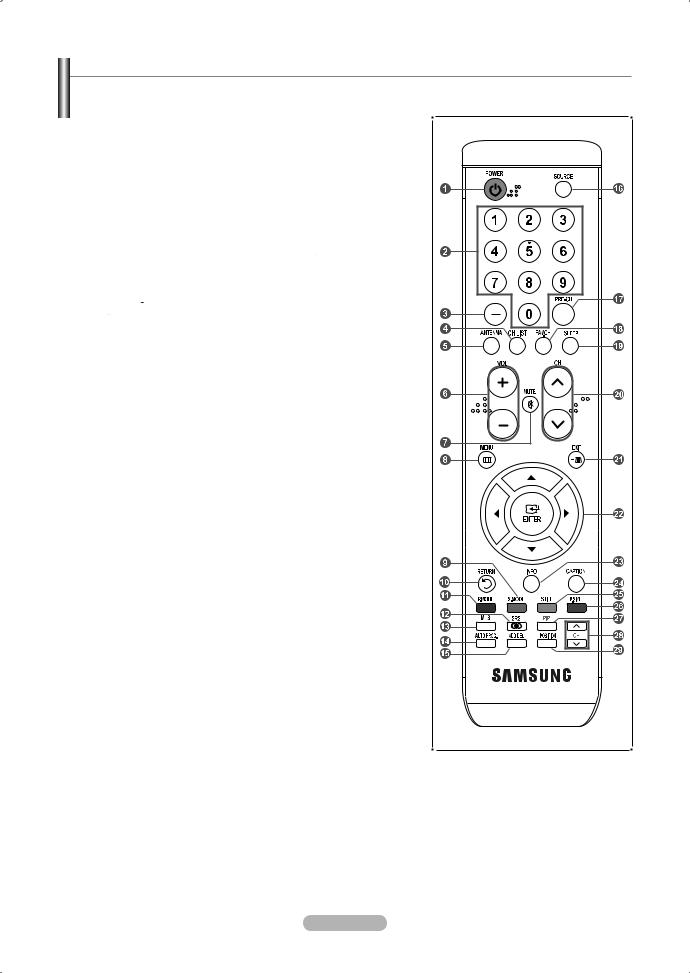
Remote Control
You can use the remote control up to a distance of about 23 feet from the TV. When using the remote, always point it directly at the TV.
1POWER
Turns the TV on and off.
2NUMERIC BUTTONS
Press to change the channel.
3–
Press to select additional channels(digital and analog) being broadcast by the same station. For example, to select channel “54-3”, press “54”, then press “–” and “3”.
4CH LIST
Used to display Channel Lists on the screen.
5ANTENNA
Press to select “AIR” or “CABLE”.
6VOL / VOL
/ VOL
Press to increase or decrease the volume.
7 (MUTE)
(MUTE)
Press to temporarily cut off the sound.
8MENU
Displays the main on-screen menu.
9S.MODE
Press to select the sound mode.
0RETURN
Returns to the previous menu.
!P.MODE
Press to select the picture mode.
@SRS
Selects SRS TruSurround XT mode.
#MTS
Press to choose stereo, mono or Separate Audio Program
(SAP broadcast).
$ AUTO PROG.
Press to automatically store selected TV/Cable channels.
%ADD/DEL
Use to store and delete channels to/from memory.
^SOURCE
Press to display all of the available video sources.
&PRE-CH
Tunes to the previous channel.
*FAV.CH
Press to switch to your favorite channels.
( SLEEP
Press to select a preset time interval for automatic ahut off.
) CH  / CH
/ CH
Press to change channels.
aEXIT
Press to exit the menu.
bUP▲ / DOWN▼ / LEFT◄ /
RIGHT► / ENTER 
Use to select on-screen menu items and change menu values.
cINFO
Press to display information on the TV screen.
dCAPTION
Controls the caption decoder.
eSTILL
Press to stop the action during a particular scene.
Press again to resume normal video.
fP.SIZE
Picture size selection.
gPIP
Picture-in Picture ON/OFF.
hCH
Displays the available channels in sequence. (These buttons change channels in the PIP window only.)
iPOSITION
Change the position of the PIP screen.
 This is a special remote control for the visually impaired, and has Braille points on the Power, Channel and Volume buttons.
This is a special remote control for the visually impaired, and has Braille points on the Power, Channel and Volume buttons.
English -
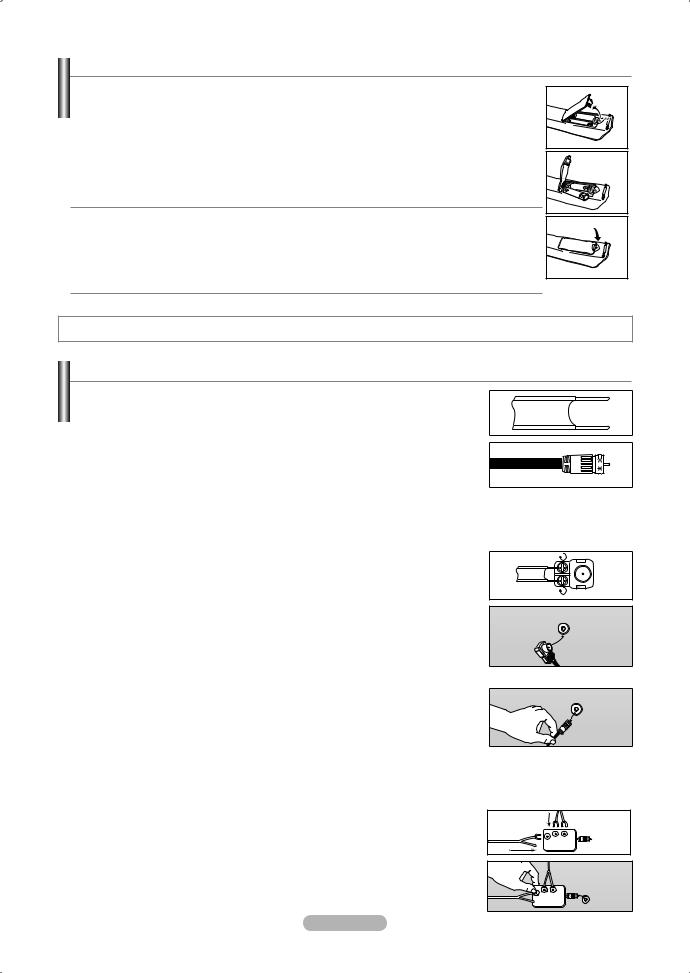
Installing Batteries in the Remote Control
1.Lift the cover at the back of the remote control upward as shown in the figure.
2. Install two AAA size batteries.
 Make sure to match the "+" and "–" ends of the batteries with the diagram inside the compartment.
Make sure to match the "+" and "–" ends of the batteries with the diagram inside the compartment.
3.Replace the cover.
 Remove the batteries and store them in a cool, dry place if you won’t be using the remote control for a
Remove the batteries and store them in a cool, dry place if you won’t be using the remote control for a
long time.
The remote control can be used up to about 23 feet from the TV. (Assuming typical TV usage, the batteries should last for about one year.)
 If the remote control doesn’t work, check the following:
If the remote control doesn’t work, check the following:
1.Is the TV power on?
2.Are the plus and minus ends of the batteries reversed?
3. Are the batteries drained?
4.Is there a power outage, or is the power cord unplugged?
5.Is there a special fluorescent light or neon sign nearby?
Connections
Connecting VHF and UHF Antennas
If your antenna has a set of leads that look like the diagram to the right, see "Antennas with 300
Ω Flat Twin Leads" below.
If your antenna has one lead that looks like diagram to the right, see "Antennas with 75 Ω Round
Leads".
If you have two antennas, see "Separate VHF and UHF Antennas".
Antennas with 300 Ω Flat Twin Leads
If you are using an off-air antenna (such as a roof antenna or "rabbit ears") that has 300 Ω twin flat leads, follow the directions below.
1. Place the wires from the twin leads under the screws on a 300-75 Ω adapter
(not supplied). Use a screwdriver to tighten the screws.
2.Plug the adaptor into the ANT 2 IN (CABLE) terminal on the back of the TV.
Antennas with 75 Ω Round Leads
1.Plug the antenna lead into the ANT 1 IN (AIR) terminal on the back of the TV.
Separate VHF and UHF Antennas
ANT 2 IN
(CABLE)
ANT 1 IN (AIR)
If you have two separate antennas for your TV (one VHF and one UHF), you must combine the two antenna signals before connecting the antennas to the TV. This procedure requires an optional combiner-adaptor (available at most electronics shops).
1. Connect both antenna leads to the combiner.
UHF

 VHF
VHF
2.Plug the combiner into the ANT 1 IN (AIR) terminal on the bottom of the rear panel.
ANT 1 IN
(AIR)
UHF
 VHF
VHF
English -

Connecting Cable TV
To connect to a cable TV system, follow the instructions below.
Cable without a Cable Box
1.Plug the incoming cable into the ANT 2 IN (CABLE) terminal on the back of the TV.
 Because this TV is cable-ready, you do not need a cable box to view unscrambled cable channels.
Because this TV is cable-ready, you do not need a cable box to view unscrambled cable channels.
Connecting to a Cable Box that Descrambles All Channels
1.Find the cable that is connected to the ANT OUT terminal on your cable box.
 This terminal might be labeled "ANT OUT", "VHF OUT" or simply, "OUT".
This terminal might be labeled "ANT OUT", "VHF OUT" or simply, "OUT".
2.Connect the other end of this cable to the ANT 2 IN (CABLE) terminal on the back of the TV.
ANT 2 IN
(CABLE)
ANT IN |
ANT OUT |
ANT 2 IN (CABLE)
Connecting to a Cable Box that Descrambles Some Channels
If your cable box descrambles only some channels (such as premium channels), follow the instructions below. You will need a twoway splitter, an RF (A/B) switch, and four lengths of RF cable. (These items are available at most electronics stores.)
1.Find and disconnect the cable that is connected to the ANT IN terminal on your cable box.
 This terminal might be labeled "ANT IN", "VHF IN" or simply, "IN".
This terminal might be labeled "ANT IN", "VHF IN" or simply, "IN".
2.Connect this cable to a two-way splitter.
 ANT IN
ANT IN
Incoming
cable Splitter
3.Connect an RF cable between the OUTPUT terminal on the splitter and the IN terminal on the cable box.
Incoming
cable
Splitter
Cable Box
4.Connect an RF cable between the
ANT OUT terminal on the cable box and the B–IN terminal on the RF(A/B) switch.
Incoming
cable
Splitter
|
RF (A/B) |
Cable Box |
Switch |
5.Connect another cable between the other OUT terminal on the splitter and the A–IN terminal on the RF (A/B) switch.
6.Connect the last RF cable between the OUT terminal on the RF (A/B) switch and the ANT IN terminal on the rear of the TV.
Incoming |
|
|
|
|
cable |
|
Splitter |
|
|
|
|
|
RF (A/B) |
|
|
|
|
|
|
|
|
|
Cable Box |
Switch |
|
|
|
|
ANT IN |
Incoming |
|
|
|
TV Rear |
cable |
Splitter |
|
|
|
|
RF (A/B) |
|
||
|
|
|
||
|
|
|
|
|
|
|
Cable Box |
Switch |
|
After you have made this connection, set the A/B switch to the "A" position for normal viewing. Set the A/B switch to the "B" position to view scrambled channels. (When you set the A/B switch to "B", you will need to tune your TV to the cable box’s output channel, which is usually channel 3 or 4.)
English -

Connecting a VCR
Video Connecion
These instructions assume that you have already connected your TV to an antenna or a cable TV system (according to the instructions on pages 6-7). Skip step 1 if you have not yet connected to an antenna or a cable system.
1.Unplug the cable or antenna from the back of the TV.
2.Connect the cable or antenna to the ANT IN terminal on the back of the VCR.
3.Connect an RF Cable between the ANT OUT terminal on the VCR and the ANT 1 IN (AIR) or ANT 2 IN (CABLE) terminal on the TV.
4.Connect a Video Cable between the VIDEO OUT jack on the VCR and the AV IN 1 (or AV IN 2) [VIDEO] jack on the
TV.
5.Connect Audio Cables between the AUDIO OUT jacks on the VCR and the AV IN 1 (or AV IN 2)
[R-AUDIO-L] jacks on the TV.
 If you have a “mono” (non-stereo) VCR, use a Y-connector (not supplied) to hook up to the right and left audio input jacks of the TV. If your VCR
If you have a “mono” (non-stereo) VCR, use a Y-connector (not supplied) to hook up to the right and left audio input jacks of the TV. If your VCR
is stereo, you must connect two cables.
ANT 1 IN ANT 2 IN (AIR) (CABLE)
TV Rear Panel
VCR Rear Panel
|
|
|
|
|
|
|
|
|
|
|
|
|
|
|
|
|
|
|
|
|
|
|
|
|
|
|
|
|
|
|
|
|
|
|
|
|
|
|
|
|
|
|
|
|
|
|
|
|
|
|
|
|
|
|
|
|
|
|
|
|
|
|
|
|
|
|
|
|
|
|
|
|
|
|
|
5 |
Audio Cable (Not supplied) |
|
|
|
|
|
|
|
|
|
|
|
|
|
|
|
|
|
|
|
|
2 |
|
|
|
|
|
|
Video Cable (Not supplied) |
|
|
|
|
|
|
|
|
|
|
|
4 |
|
|
|
|
|
|||
|
|
|
|
|
|
|
|
|
|
|
|||
|
|
|
|
|
|
|
|
|
|
|
|
|
|
|
|
|
|
|
|
3 |
RF Cable (Not supplied) |
|
|
|
|
|
|
|
|
|
|
|
|
|
|
|
|
|
|
|
|
Follow the instructions in “Viewing a VCR or Camcorder Tape” to view your VCR tape.
 Each VCR has a different back panel configuration.
Each VCR has a different back panel configuration.
 When connecting a VCR, match the color of the connection terminal to the cable.
When connecting a VCR, match the color of the connection terminal to the cable.
S-Video Connecion
Your Samsung TV can be connected to an S-Video signal from an VCR. (This connection delivers a better picture as compared to a standard VCR.)
1.To begin, follow steps 1–3 in the previous section to connect the antenna or cable to your VCR and your TV.
2.Connect an S-Video Cable between the S-VIDEO OUT jack on the VCR and the AV IN1 [S-VIDEO] jack on the TV.
3.Connect Audio Cables between the AUDIO OUT jacks on the VCR and the AV IN1 [R-AUDIO-L] jacks on the TV.
TV Rear Panel
VCR Rear Panel


 3 Audio Cable (Not supplied)
3 Audio Cable (Not supplied)
2 S-Video Cable (Not supplied)
1 RF Cable (Not supplied)
An S-Video cable may be included with a VCR. (If not, check your local electronics store.)
 Each VCR has a different back panel configuration.
Each VCR has a different back panel configuration.
 When connecting a VCR, match the color of the connection terminal to the cable.
When connecting a VCR, match the color of the connection terminal to the cable.
English -
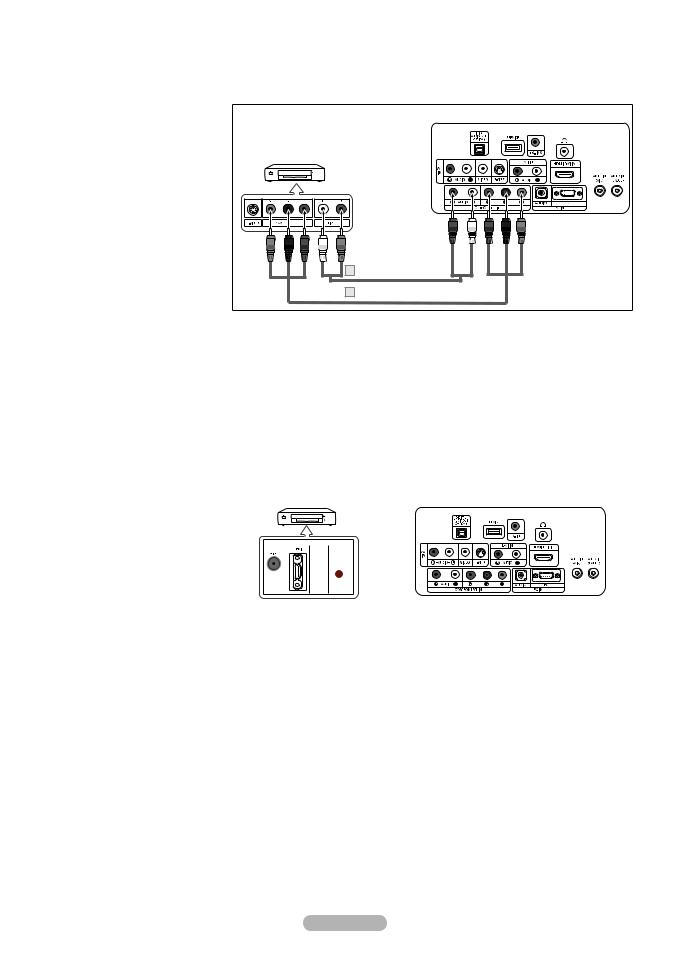
Connecting a DVD Player/Set-Top Box |
||
The rear panel jacks on your TV make it easy to connect a DVD player to your TV. |
||
1. |
Connect a Component |
TV Rear Panel |
|
Cable between the |
|
|
|
|
|
COMPONENT IN(1 or 2) |
|
|
[Y, PB, PR] jacks on the TV |
|
|
and the COMPONENT |
DVD Player/Set-Top Box |
|
[Y, PB, PR] jacks on the |
|
|
DVD/Set-top Box. |
|
2. |
Connect Audio Cables |
|
|
between the COMPONENT |
|
|
IN(1 or 2) [R-AUDIO-L] |
|
|
jacks on the TV and the |
|
|
AUDIO OUT jacks on the |
|
|
DVD/Set-top Box |
2 Audio Cable (Not supplied) |
|
|
|
|
|
1 Component Cable (Not supplied) |
|
|
Component video separates the video into Y (Luminance (brightness)), Pb (Blue) and |
|
|
Pr (Red) for enhanced video quality. |
|
|
Be sure to match the component video and audio connections. |
|
|
For example, if connecting the video cable to COMPONENT IN, connect the audio cable |
|
|
to COMPONENT IN also. |
|
|
Each DVD Player/STB has a different back panel configuration. |
|
|
When connecting a DVD player/STB, match the color of the connection terminal to the |
|
|
cable. |
Connecting a DVD Player/Set-Top Box via HDMI
This connection can only be made if there is an HDMI Output connector on the external device.
1.Connect an HDMI Cable between the HDMI/DVI IN connector on the TV and the HDMI connector on the DVD player/Set-Top Box
DVD Player Rear Panel |
TV Rear Panel |
|
|
|
HDMI Cable (Not supplied) |
What is HDMI?
•HDMI(High-Definition Multimedia Interface), is a next-generation an interface that enables the transmission of digital audio and video signals using a single cable.
•The difference between HDMI and DVI is that the HDMI device is smaller in size, has the HDCP (High Bandwidth Digital Copy Protection) coding feature installed.
 Each DVD player/STB has a different back panel configuration.
Each DVD player/STB has a different back panel configuration.
English -

Connecting a DVD Player/Set-Top Box via DVI
This connection can only be made if there is a DVI Output connector on the external device.
1.Connect a DVI to HDMI Cable or DVI-HDMI Adapter between the HDMI/DVI IN connector on the TV and the DVI connector on the
DVD player/Set-Top Box.
2.Connect Audio Cables between the DVI IN [R-AUDIO-L] jack on the
TV and the AUDIO OUT jacks on the DVD player/
Set-Top Box.
TV Rear Panel
DVD Player / Set-Top Box
Audio Cable 2 (Not supplied)
1 DVI to HDMI Cable (Not supplied)
 Each DVD player/STB has a different back panel configuration.
Each DVD player/STB has a different back panel configuration.
 When connecting a DVD player/STB, match the color of the connection terminal to the cable.
When connecting a DVD player/STB, match the color of the connection terminal to the cable.
 When using an HDMI/DVI cable connection, you must use the HDMI/DVI IN terminal.
When using an HDMI/DVI cable connection, you must use the HDMI/DVI IN terminal.
Connecting a Digital Audio System
The rear panel jacks on your TV make it easy to connect a Digital Audio System to your TV.
1.Connect an Optical Cable between the “DIGITAL AUDIO OUT (OPTICAL)” jacks on the TV and the Digital Audio Input jacks on the Digital Audio System.
When a Digital Audio System is connected to the “DIGITAL AUDIO OUT (OPTICAL)” terminal: Decrease the volume
of the TV, and adjust the volume level with the system’s volume control.
Digital Audio System
TV Rear Panel
Optical Cable (Not supplied)
 5.1CH audio is possible when the TV is connected to an external device supporting 5.1CH.
5.1CH audio is possible when the TV is connected to an external device supporting 5.1CH.  Each Digital Audio System has a different back panel configuration. .
Each Digital Audio System has a different back panel configuration. .
English - 10

Connecting a PC
1.Connect a D-Sub Cable between PC IN [PC] connector on the TV and the PC output connector on your computer.
2.Connect a PC Audio Cable between PC IN [AUDIO] jack on the TV and the Audio Out jack of the sound card on your computer.
TV Rear Panel
PC
2 PC Audio Cable (Not supplied)
1 D-Sub Cable (Not supplied)
 Each PC has a different back panel configuration.
Each PC has a different back panel configuration.
 When connecting a PC, match the color of the connection terminal to the cable.
When connecting a PC, match the color of the connection terminal to the cable.
English - 11

Operation
Turning the TV On and Off
Press the POWER button on the remote control.
button on the remote control.
You can also use the  button on the side of the panel.
button on the side of the panel.
Plug & Play Feature
When the TV is initially powered on, basic settings proceed automatically and subsequently:
1. Press the POWER button on the remote control. |
|
|
Menu language, Shop Mode, |
|
||||||||
|
|
Channels and Time will be set. |
|
|||||||||
|
The message “Menu language, Shop Mode, Channels and Time will be set.” is |
|
|
|
|
|
|
|
|
|
|
|
|
|
|
|
|
Start |
|
|
|
|
|||
|
displayed. |
|
|
|
|
|
|
|
|
|||
|
|
|
|
|
|
|
|
|
|
|
||
|
Press the ENTER button, then “Select the language of the OSD” menu is |
|
|
|
|
|
|
|
|
|
|
|
|
automatically displayed. |
|
|
|
|
Plug & Play |
|
|
|
|||
|
|
|
|
Select the language of the OSD. |
|
|||||||
|
|
|
|
|
|
|||||||
2. Press the ▲ or ▼ buttons to select language, then press the ENTER button. |
|
|
Language |
|
|
English |
|
|
|
|||
|
|
|
|
|
|
Español |
|
|
|
|||
|
The message “Select Home Mode when installing this TV at home.” is displayed. |
|
|
|
|
|
|
Français |
|
|
|
|
3. |
Press the ◄ or ► buttons to select “Shop” or “Home”, then press the |
|
|
|
Move |
|
|
Enter |
|
|
Skip |
|
|
ENTER button. |
|
|
|
|
|
|
|
||||
|
|
|
|
|
|
|
|
|
|
|
|
|
|
The message “Select the antennas to memorize.” is displayed. |
|
|
|
|
|
|
|
|
|
|
|
|
|
|
|
Plug & Play |
|
|
|
|||||
|
We recommend setting the TV to Home mode for the best picture in your |
|
Select Home Mode when installing this TV at home. |
|||||||||
|
home environment. |
|
|
|
|
|
|
|
|
|
|
|
|
Shop mode is only intended for use in retail environments. |
|
|
Shop |
|
|
|
Home |
|
|||
|
|
|
|
|
|
|
|
|
|
|
||
|
If the unit is accidentally set to Shop mode and you want to return to Dynamic |
|
|
|
|
|
|
|
|
|
|
|
|
(Home) mode, press any Volume button and then hold down the MENU button |
|
|
|
|
|
|
|
|
|
|
|
|
for five seconds on the side panel of the TV. |
|
|
Move |
|
|
Enter |
|
|
Skip |
||
|
|
|
|
|
|
|
|
|
|
|
|
|
4. |
Press the ▲ or ▼ buttons to memorize the channels of the selected connection. |
|
|
|
Plug & Play |
|
|
|
||||
|
Press the ENTER button to select “Start”. |
|
Select the antennas to memorize. |
|
||||||||
|
|
|
|
|
|
|
|
|
|
|
||
|
If the antenna is connected to ANT 1(AIR), select “Air” and if it is connected to |
|
Air |
|
|
Start |
|
|
|
|||
|
ANT 2 (CABLE), select “Cable”. |
|
Cable |
|
|
Start |
|
|
|
|||
|
If both ANT 1 (AIR) and ANT 2 (CABLE) are connected, select the “Air + Cable”. |
|
Air+Cable |
|
|
Start |
|
|
|
|||
|
In Cable mode, you can select the correct signal source among STD, HRC, |
|
|
Move |
|
|
Enter |
|
|
Skip |
||
|
and IRC by pressing the ▲ or ▼ button, then press the ENTER button. |
|
|
|
|
|
|
|
|
|
|
|
|
|
|
|
Plug & Play |
|
|
|
|||||
|
Contact your local cable company to identify the type of cable system that |
|
Auto Program in progress. |
|
|
|
||||||
|
exists in your particular area. |
|
Air Channel 50 |
|||||||||
|
|
|
|
|
|
|
|
|||||
5. The TV will begin memorizing all of the available channels. |
|
|
|
|
|
|
|
|
|
35% |
||
|
|
|
|
|
|
|
|
|
|
|||
|
After all the available channels are stored, the Auto program menu reappears. |
|
|
|
|
Stop |
|
|
|
|
||
|
Press the ENTER button when channel memorization is complete. |
|
|
|
|
|
|
|
|
|
|
|
|
The message “Select the clock mode.” is displayed. |
|
|
|
|
|
Enter |
|
|
Skip |
||
|
To stop the search before it has finished, press the ENTER button with stop |
|
|
|
|
|
|
|
|
|||
|
|
|
|
Plug & Play |
|
|
|
|||||
|
selected. |
|
Auto Program is completed. |
|
|
|
||||||
|
|
|
|
16 Channels were memorized. |
|
|
|
|||||
|
|
|
|
Air : 16, Cable : 0. |
|
|
|
|
|
|
||
6. |
Press the ENTER button. |
|
|
|
|
|
|
|
|
|
Skip |
|
|
|
|
|
|
|
|
|
|
|
|
|
|
|
Press the ▲ or ▼ buttons to select “Manual” or “Auto”, then Press the |
|
|
Clock Set |
Plug & Play |
|
|
|
||||
|
|
|
|
|
|
|||||||
|
|
|
|
|
|
|
||||||
|
ENTER button. |
|
|
Select the clock mode. |
|
|
|
|||||
|
The message “Set to daylight savings time.” is displayed. |
|
|
Clock Mode |
: |
|
|
|
|
|
|
|
|
|
|
|
|
Auto |
|
|
|
||||
|
|
|
|
|
|
|
|
Manual |
|
|
|
|
|
|
|
|
|
Move |
|
|
Enter |
|
|
Skip |
|
English - 12
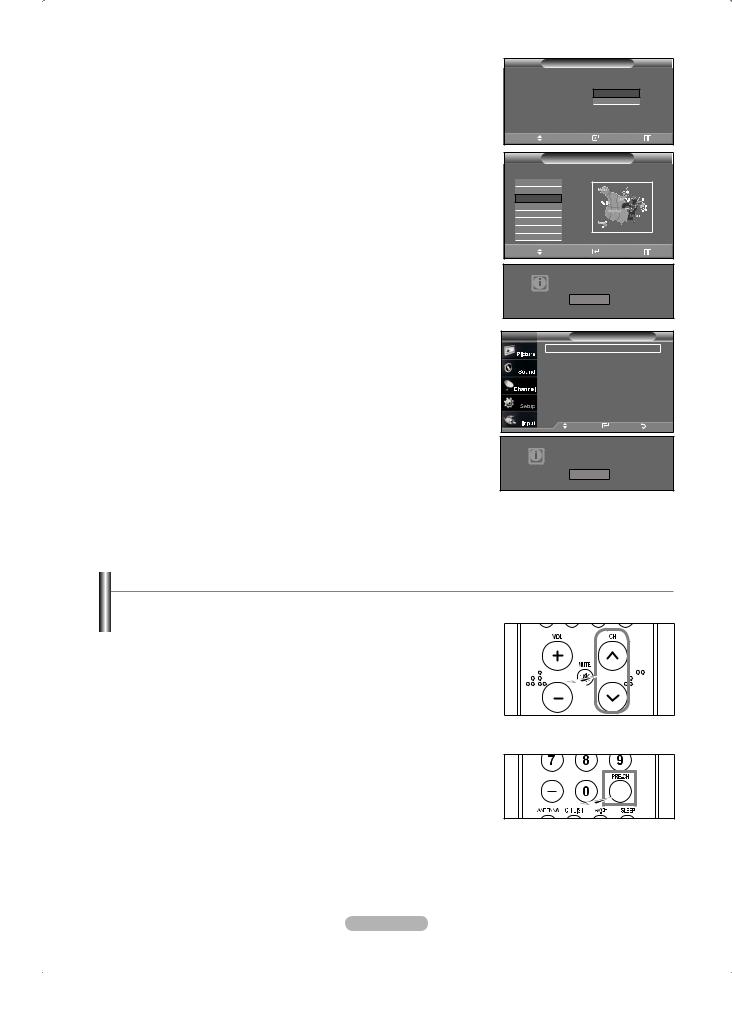
7.Press the ▲ or ▼ buttons to select “On” or “Off”, then Press the ENTER button. The message “Select the time zone where you are located.” is displayed.
8.Press the ▲ or ▼ buttons to highlight the time zone for your local area.
Press the ENTER button. If you have received a digital signal, the time will be set automatically.
If not, see page 38 to set the clock.
9.The message “Enjoy your watching.” is displayed. When you have finished, press the ENTER button.
Plug & Play |
|
|
Set to daylight savings time. |
|
|
Daylight Savings Time |
On: |
|
|
Off |
|
Move |
Enter |
Skip |
Plug & Play
Select the time zone where you are located.
Newfoundland
Atlantic
Eastern
Central
Mountain
Pacific
Alaska
Hawaii
Move |
Enter |
Skip |
Enjoy your watching.
OK
If you want to reset this feature...
1.Press the MENU button to display the menu.
Press the ▲ or ▼ buttons to select "Setup", then press the ENTER button.
2.Press the ENTER button again, to select "Plug & Play".
3.The message "Menu language, Shop Mode, Channels and Time will be set." is displayed.
TV |
Setup |
|
Plug & Play |
|
► |
Language |
: English |
► |
Time |
|
► |
Game Mode |
: Off |
► |
V-Chip |
|
► |
Caption |
|
► |
Menu Transparency |
: High |
► |
▼More |
|
|
Move |
Enter |
Return |
Menu language, Shop Mode,
Channels and Time will be set.
Start
Changing Channels
Using the Channel Buttons
1.Press the CH or CH
or CH button to change channels.
button to change channels.
 When you press the CH
When you press the CH  or CH
or CH button, the TV changes channels in sequence.
button, the TV changes channels in sequence.
You will see all the channels that the TV has memorized. (The TV must have memorized at least three channels). You will not see channels that were either erased or not memorized. See page 15 to memorize channels.
Using the PRE-CH Button to select the Previous Channel
1.Press the PRE-CH button.
The TV will switch to the last channel viewed.
 To quickly switch between two channels that are far apart, tune to one channel, then use the number button to select the second channel. Then use the PRE-CH button to quickly alternate between them.
To quickly switch between two channels that are far apart, tune to one channel, then use the number button to select the second channel. Then use the PRE-CH button to quickly alternate between them.
English - 13
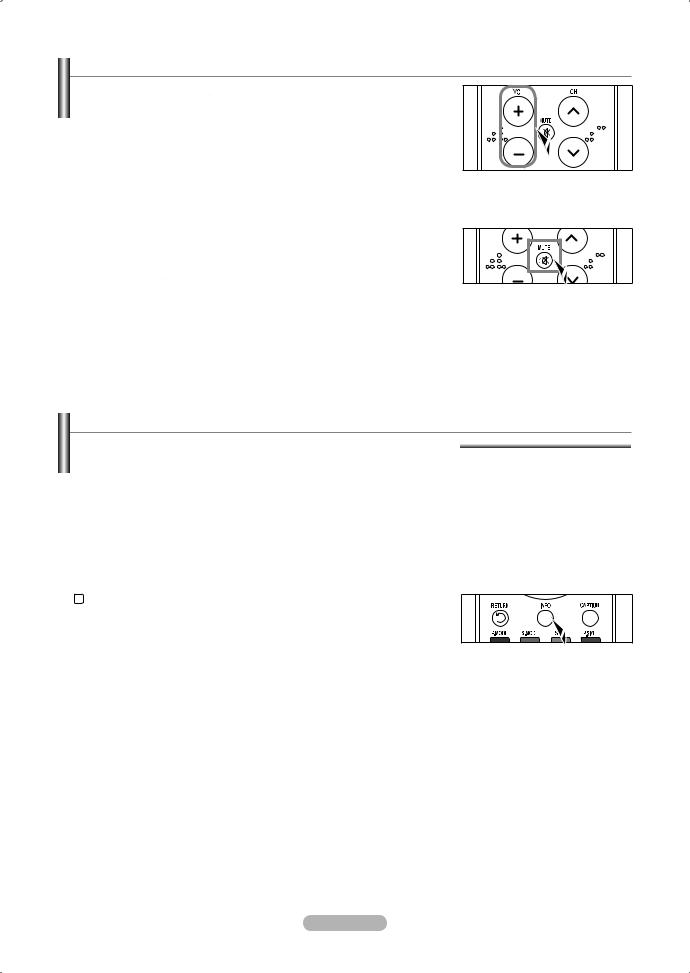
Adjusting the Volume
1. Press the VOL  or VOL
or VOL  buttons to decrease or increase the volume.
buttons to decrease or increase the volume.
Using Mute
At any time, you can cut off the sound using the MUTE button.
1.Press MUTE button and the sound cuts off.
The word " " will appear in the lower-left corner of the screen.
" will appear in the lower-left corner of the screen.
2.To turn mute off, press the MUTE button again, or simply press the VOL  or VOL
or VOL  buttons.
buttons.
Viewing the Display
The display identifies the current channel and the status of certain audio-video settings.
1.Press the INFO button on the remote control.
The TV will display the channel, the type of sound, and the status of certain picture and sound settings.
|
Air |
|
|
|
Mono |
|
|
|
|
|
|
|
Picture Mode |
: Dynamic |
|
|
Sound Mode |
: Custom |
|
|
MTS |
: Stereo |
|
|
Caption |
: On |
|
|
V-Chip |
: On |
|
|
05 : 54 pm |
|
|
|
|
|
|
 Press the INFO button once more or wait approximately 10 seconds and the display disappears automatically.
Press the INFO button once more or wait approximately 10 seconds and the display disappears automatically.
English - 14

Viewing the Menus
1.With the power on, press the MENU button.
The main menu appears on the screen. The menu’ s left side has five icons: Picture, Sound, Channel, Setup, Input.
2.Use the ▲ or ▼ buttons to select one of the five icons.
Then press the ENTER button to access the icon’s sub-menu.
3.Press the EXIT button to exit.
 The on-screen menus disappear from the screen after about one minute.
The on-screen menus disappear from the screen after about one minute.
TV |
|
Picture |
|
Mode |
|
: Dynamic |
► |
Contrast |
|
|
00 |
Brightness |
|
|
|
Sharpness |
|
|
|
Color |
|
|
|
Tint |
G 50 |
|
R 50 |
Color Tone |
: Cool1 |
► |
|
▼More |
|
|
|
Move |
Enter |
Return |
|
Memorizing the Channels
Your TV can memorize and store all of the available channels for both "off-air" (Air) and "Cable" channels. After the available channels are memorized, use the CH or CH
or CH buttons to scan through the channels. This eliminates the need to change channels by entering the channels digits. There are three steps for memorizing channels: selecting a broadcast source, memorizing the channels (automatic) and adding or deleting channels (Channel Lists).
buttons to scan through the channels. This eliminates the need to change channels by entering the channels digits. There are three steps for memorizing channels: selecting a broadcast source, memorizing the channels (automatic) and adding or deleting channels (Channel Lists).
Selecting the Video Signal-source
Before your television can begin memorizing the available channels, you must specify the type of signal source that is connected to the TV (i.e. an Air or a Cable system).
1.Press the MENU button to display the menu.
Press the ▲ or ▼ buttons to select "Channel", then press the
ENTER button.
2.Press the ENTER button select “Antenna”.
Press the ▲ or ▼ buttons to select “Air” or “Cable”, then press the ENTER button.
Press the EXIT button to exit.
TV |
Channel |
|
Antenna |
: Air |
► |
Auto Program |
|
► |
Clear Scrambled Channel |
► |
|
Channel List |
|
► |
Name |
|
► |
Fine Tune |
|
► |
Signal Strength |
|
► |
LNA |
: On |
► |
Move |
Enter |
Return |
TV |
Channel |
|
Antenna |
: AirAir |
|
|
|
Auto Program |
|
Cable |
|
|
Clear Scrambled Channel |
|
|
||
Channel List |
|
|
|
|
Name |
|
|
|
|
Fine Tune |
|
|
|
|
Signal Strength |
|
|
|
|
LNA |
: On |
|
|
|
Move |
Enter |
Return |
||
English - 15

Storing Channels in Memory (Automatic Method)
1.Press the MENU button to display the menu.
Press the ▲ or ▼ buttons to select “Channel”, then press the ENTER button.
2.Press the ▲ or ▼ buttons to select "Auto Program", then press the ENTER button.
3.Press the ▲ or ▼ buttons to select the antenna connection, then press the
ENTER button.
 Air: “Air” antenna signal. / Cable: “Cable” antenna signal. / Air+Cable: “Air” and “Cable” antenna signals.
Air: “Air” antenna signal. / Cable: “Cable” antenna signal. / Air+Cable: “Air” and “Cable” antenna signals.
4.When selecting the Cable TV system: Press the ENTER button to start the auto program. By default, the cable TV system is set to “STD”. If you want to select another type of cable system, press the ▲ or ▼ button to select “STD”, “HRC” or
“IRC”.
 STD, HRC and IRC identify various types of cable TV systems. Contact your local cable company to identify the type of cable system that exists in your particular area. At this point the signal source has been selected.
STD, HRC and IRC identify various types of cable TV systems. Contact your local cable company to identify the type of cable system that exists in your particular area. At this point the signal source has been selected.
Press the ENTER button to start the auto program.
 To stop the search before it has finished, press the ENTER button with stop selected.
To stop the search before it has finished, press the ENTER button with stop selected.
5.After all the available channels are stored, the “Auto Program” menu reappears. Press the EXIT button to exit.
TV |
Channel |
|
Antenna |
: Air |
► |
Auto Program |
|
► |
Clear Scrambled Channel |
► |
|
Channel List |
|
► |
Name |
|
► |
Fine Tune |
|
► |
Signal Strength |
► |
|
LNA |
: On |
► |
Move |
Enter |
Return |
TV |
Auto Program |
|
Select the antennas to memorize.
|
Air |
|
Start |
|
|
|
Cable |
|
Start |
|
|
|
|
|
|
|
|
|
Air+Cable |
|
Start |
|
|
|
Move |
Enter |
Return |
||
|
|
|
|
||
TV |
Auto Program |
|
|
||
Selects a cable signal type for your location.
Analog |
|
|
|
STD |
|
Start |
|
HRC |
|
|
|
IRC |
|
|
|
Digital |
|
|
|
STD |
|
|
|
HRC |
|
|
|
IRC |
|
|
|
Move |
Enter |
Return |
|
Auto Program
Auto Program in Progress.
Cable 50
50%
Stop
Enter |
Return |
Plug & Play
Auto Program is completed. 25 Channels are memorized. Air : 18, Cable : 7.
Enter |
Return |
English - 16
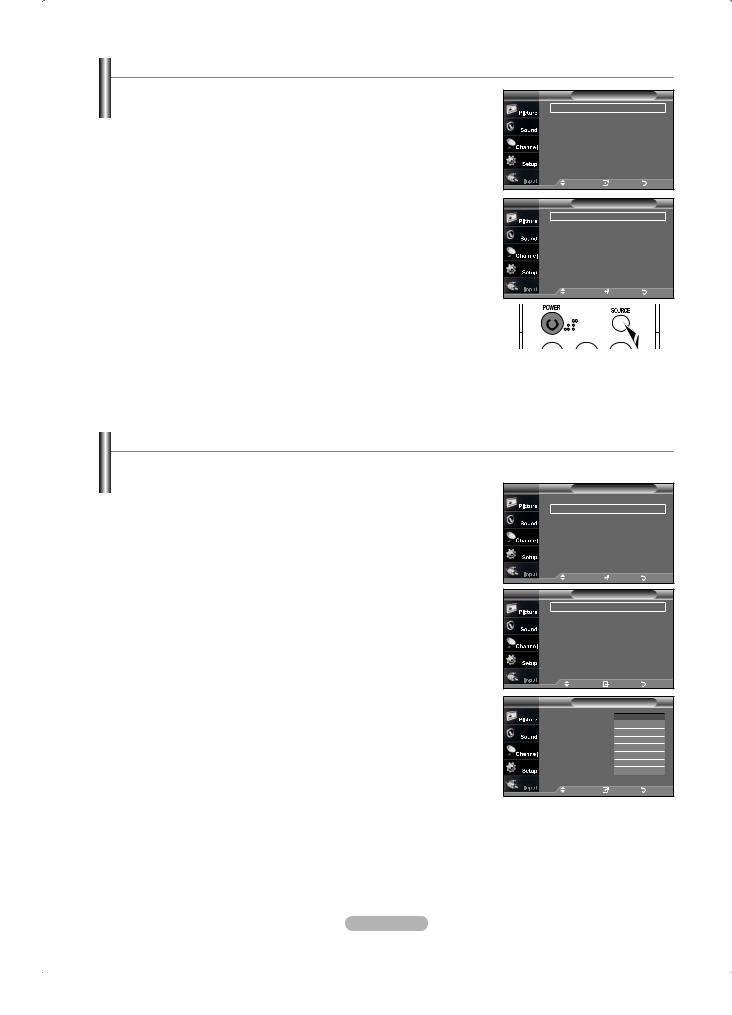
To Select the Source
Use to select TV or other external input sources connected to the TV. Use to select the input source of your choice.
1.Press the MENU button to display the menu.
Press the▲ or ▼ buttons to select “Input”, then press the ENTER button.
2.Press the ENTER button to select "Source List".
Press the ▲ or ▼ buttons to select signal source, then press the ENTER button.
 When you connect equipment to the LCD, you can choose between the following sets of jacks: TV, AV, S-Video, Component, PC, HDMI on the TV’s rear panel.
When you connect equipment to the LCD, you can choose between the following sets of jacks: TV, AV, S-Video, Component, PC, HDMI on the TV’s rear panel.
 HDMI input can only be selected when the external device is turned on and connected via HDMI.
HDMI input can only be selected when the external device is turned on and connected via HDMI.
 You can choose only those external devices that are connected to the TV.
You can choose only those external devices that are connected to the TV.
 Press the SOURCE button on the remote control to view an external signal source.
Press the SOURCE button on the remote control to view an external signal source.
TV |
Input |
|
Source List |
: TV |
► |
Edit Name |
|
► |
Move |
Enter |
Return |
TV |
Source List |
|
|
TV |
|
|
|
AV |
: ---- |
|
|
S-Video |
: ---- |
|
|
Component |
: ---- |
|
|
PC |
: ---- |
|
|
HDMI |
: ---- |
|
|
Move |
Enter |
Return |
|
|
|
|
|
|
|
|
|
|
|
|
|
|
|
|
To Edit the Input Source Name
Name the device connected to the input jacks to make your input source selection easier.
1.Press the MENU button to display the menu.
Press the▲ or ▼ buttons to select “Input”, then press the ENTER button. Press the ▲ or ▼ buttons to select "Edit Name", then press the ENTER button.
2.Press the ▲ or ▼ buttons to select "AV", "S-Video", "Component", "PC", "HDMI" input jack, then press the ENTER button.
3.Press the ▲ or ▼ buttons to select "VCR", "DVD", "D-VHS", "Cable STB",
"HD STB", "Satellite STB", "PVR STB", "AV Receiver", "DVD Receiver", "Game", "Camcorder", "DVD Combo", "DVD HDD Recoder", "PC",
"Internet TV Recv.","Interactive TV Recv.","VOD STB", "TV" input source, then press the ENTER button.
Press the EXIT button to exit.
TV |
Input |
|
Source List |
: TV |
► |
Edit Name |
|
► |
Move |
Enter |
Return |
TV |
Edit Name |
|
AV |
: ---- |
► |
S-Video |
: ---- |
► |
Component |
: ---- |
► |
PC |
: ---- |
► |
HDMI |
: ---- |
► |
Move |
Enter |
Return |
TV |
Edit Name |
|
AV |
: |
|
---- |
► |
|
|
|
|
|||||
S-Video |
: |
|
---- |
|
|
|
|
VCR |
|
|
|
||
Component |
: |
|
DVD |
|
|
|
PC |
: |
|
D-VHS |
|
|
|
HDMI |
: |
|
Cable STB |
|||
|
|
|
HD STB |
|
|
|
|
|
|
Satellite STB |
|||
|
|
|
▼ |
|
|
|
Move |
Enter |
Return |
||||
English - 17

Picture Control
Using Automatic Picture Settings
Your TV has Three automatic picture settings ("Dynamic", "Standard", "Movie") that are preset at the factory. You can activate either Dynamic, Standard, Movie by making a selection from the menu.
1.Press the MENU button to display the menu. Press the ENTER button, to select "Picture".
2.Press the ENTER button to select "Mode".
Press the ▲ or ▼ buttons to select the "Dynamic", "Standard", "Movie" picture setting. Press the ENTER button.
Choose Dynamic to increase the clarity and sharpness of the picture.
Choose Standard for the standard factory settings.
Choose Movie for a natural Image without picture enhancements.
3.Press the ▲ or ▼ buttons to select "Contrast", "Brightness", "Sharpness",
"Color", or "Tint(G/R)", then press the ENTER button.
4.Press the ◄ or ► buttons to decrease or increase the value of a particular item. For example, if you select "Contrast", pressing the ► button increases it.
Press the EXIT button to exit.
 • When you make changes to Contrast, Brightness, Sharpness, Color, Tint(G/R) OSD will be also adjusted accordingly.
• When you make changes to Contrast, Brightness, Sharpness, Color, Tint(G/R) OSD will be also adjusted accordingly.
•When in PC mode, Tint, Sharpness, and Color are not available.
 Press the P.MODE button on the remote control repeatedly to select the desired picture mode.
Press the P.MODE button on the remote control repeatedly to select the desired picture mode.
TV |
|
Picture |
|
|
|
Mode |
|
: Dynamic |
► |
||
Contrast |
|
|
|
|
00 |
Brightness |
|
|
|
|
|
Sharpness |
|
|
|
|
|
Color |
|
|
|
|
|
Tint |
G 50 |
|
|
|
R 50 |
Color Tone |
: Cool1 |
|
► |
||
▼More |
|
|
|
|
|
Move |
|
Enter |
|
Return |
|
TV |
|
Picture |
|
|
|
Mode |
|
: |
|
ic |
|
Contrast |
|
|
Dynamic |
00 |
|
|
|
Standard |
|||
Brightness |
|
Movie |
|
|
|
Sharpness |
|
|
|
|
|
Color |
|
|
|
|
|
Tint |
G 50 |
|
|
|
R 50 |
Color Tone |
: Cool1 |
|
|
||
▼More |
|
|
|
|
|
Move |
|
Enter |
|
Return |
|
TV |
|
Picture |
|
|
|
Mode |
|
: Dynamic |
|
||
Contrast |
|
|
|
|
00 |
Brightness |
|
|
|
|
|
Sharpness |
|
|
|
|
|
Color |
|
|
|
|
|
Tint |
G 50 |
|
|
|
R 50 |
Color Tone |
: Cool1 |
|
|
||
▼More |
|
|
|
|
|
Move |
|
Enter |
|
Return |
|
▲ |
|
|
|
|
100 |
Contrast |
|
|
|
|
|
▼ |
|
|
|
|
|
Move |
Adjust |
Return |
English - 18

Adjusting the Color Tone
You can change the color of the entire screen according to your preference.
1.Press the MENU button to display the menu. Press the ENTER button to select "Picture".
2.Press the ▲ or ▼ buttons to select "Color Tone", then press the ENTER button.
3.Press the ▲ or ▼ buttons to select "Cool2", "Cool1", "Normal", "Warm1", or "Warm2".
Press the ENTER button.
 When the picture mode is set to Dynamic or Standard, Warm1 and Warm2 cannot be selected. Movie mode is only available .
When the picture mode is set to Dynamic or Standard, Warm1 and Warm2 cannot be selected. Movie mode is only available .
 This function is available in PC mode.
This function is available in PC mode.
Resetting the Picture Settings to the Factory Defaults
1.Press the ▲ or ▼ buttons to select "Reset", then press the ENTER button. Press the ▲ or▼ button to select “OK”, or “Cancel”, then press the ENTER button. Press the EXIT button to exit.
 Each mode can be reset.
Each mode can be reset.
TV |
|
Picture |
|
|
Mode |
|
: Dynamic |
► |
|
Contrast |
|
|
00 |
|
Brightness |
|
|
||
Sharpness |
|
|
||
Color |
|
|
|
|
Tint |
G 50 |
|
R 50 |
|
Color Tone |
: Cool1 |
► |
||
▼More |
|
|
|
|
Move |
Enter |
Return |
||
TV |
|
Picture |
|
|
Mode |
|
: Dynamic |
|
|
Contrast |
|
|
00 |
|
Brightness |
|
|
||
Sharpness |
Cool2 |
|
||
Color |
|
|
||
|
Cool1 |
|||
Tint |
G 50 |
50 |
||
Normal |
||||
Color Tone |
|
|||
Warm1 |
|
|||
▼More |
|
Warm2 |
|
|
Move |
Enter |
Return |
||
TV |
|
Picture |
|
|
▲More |
|
Size |
: 16 : 9 |
Digital NR |
: Off |
Reset |
: OK |
|
Cancel |
Move |
Enter |
Return |
Freezing the Picture
1. Press the STILL button to freeze a moving picture.
Normal sound will still be heard. Press again to cancel.
While V-Chip is in operation, the Still function cannot be used.
Setting the Film Mode
You can: automatically senses and processes film signals from all sources and adjusts the picture for optimum quality.
1.Press the MENU button to display the menu.
Press the ▲ or ▼ buttons toselect “Setup”, then press the ENTER button.
2.Press the ▲ or ▼ buttons to select "Flim Mode", then press the ENTER button.
3.Press the ▲ or ▼ buttons to select "On" or "Off", then press the ENTER button.
Press the EXIT button to exit.
Film mode is supported in TV, VIDEO, S-VIDEO, and COMPONENT480i.
TV |
Picture |
|
▲More |
|
|
Melody |
: Off |
► |
PC |
|
► |
HDMI Black Level |
: Normal |
► |
Film Mode |
: Off |
► |
PIP |
|
► |
Function Help |
: On |
► |
▼More |
|
|
Move |
Enter |
Return |
TV |
Picture |
|
▲More |
|
Melody |
: Off |
PC |
|
HDMI Black Level |
: Normal |
Film Mode |
: Offff |
PIP |
On |
Function Help |
: On |
▼More |
|
Move |
Enter |
Return |
English - 19
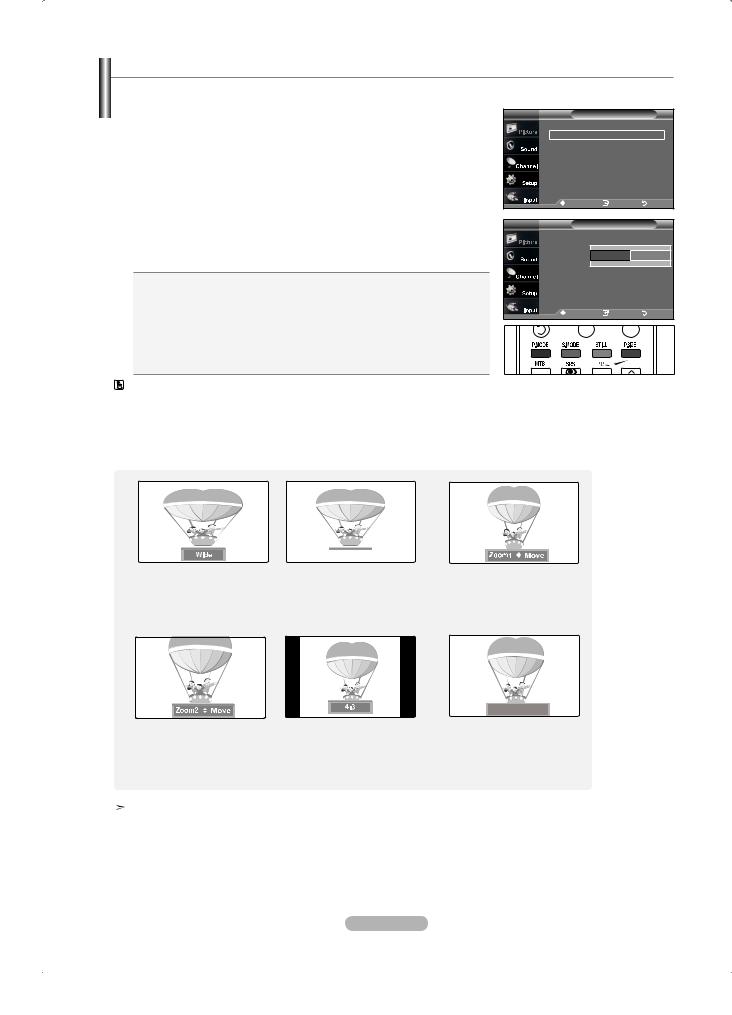
Changing the Screen Size
Screen size selection depends on the type of video input.
1.Press the MENU button to display the menu. Press the ENTER button, to select "Picture".
2.Press the ▲ or ▼ buttons to select "Size", then press the ENTER button.
TV |
Picture |
|
▲More |
|
|
Size |
: 16:9 |
► |
Digital NR |
: Off |
► |
Reset |
: OK |
► |
Move |
Enter |
Return |
3.Press the ▲ or ▼ buttons to select the screen format you want.
Press the ENTER button. Press the EXIT button to exit.
•Wide : Adjusts the picture size to Wide appropriate for DVDs or wide broadcasting.
•16:9 : Sets the picture to 16:9 wide mode.
•Zoom1 : Magnifies the size of the picture on the screen.
•Zoom2 : Magnifies the size of the picture more than “Zoom1”.
•4:3 : Sets the picture to 4:3 normal mode.
•Just Scan : Use the function to see the full image without any cutoff
when HDMI 720p/1080i signals are input.
Alternately, you can press the P.SIZE button on the remote control repeatedly to change the picture size.
 If you watch a still image or the 4:3 mode for a long time (over 2 hours), an
If you watch a still image or the 4:3 mode for a long time (over 2 hours), an
image may be burned onto the screen. View the TV in 16:9 mode as much as possible.
 HD (High Definition)
HD (High Definition)
16:9 - 1080i (1920x1080), 720P (1280x720)
TV |
Size |
|
Wide |
|
|
16 : 9 |
▲ |
|
Zoom1 |
Position |
Reset |
Zoom2 |
▼ |
|
4 : 3 |
|
|
Just Scan |
|
|
Move |
Enter |
Return |
Wide
Adjusts the picture size to Wide appropriate for DVDs or wide broadcasting.
16:9 |
|
|
Zoom1 |
|
|
||
Sets the picture to 16:9 wide mode. |
The screen size when Wide |
||
|
|
|
screen is vertically enlarged. |
 Just Scan
Just Scan 
Zoom2 |
4:3 |
The screen size when the |
Sets the picture to 4:3 |
Zoom1 screen is vertically |
normal mode. |
enlarged. |
|
Just Scan
Use the function to see the full image without any cutoff when HDMI 720p/1080i signals are input.
•In TV, VIDEO, S-VIDEO,and all COMPONENT (480i, 480p), DTV (480i, 480p) modes, all screen modes can be selected. (Wide • 16:9 • Zoom1 • Zoom2 • 4:3).
•You can select only the Wide, 16:9 and 4:3 screen sizes in the DTV Component (720p, 1080i) or HDMI (720p, 1080i) mode.
•In PC mode, only Wide & 4:3 modes can be selected.
•You must select Zoom with P. Size button on the remote if you want to move the Zoom1 or 2 picture up or down.
•When watching a DTV’s HD signal, you can use. Horizontal zoom sets the optical picture format by
expanding it both horizontally and vertically. For example, you can reset the picture in 4:3 format to 16:9. Does not support all external devices (DVD, VCR etc.).
English - 20

Viewing Picture-in-Picture
This product has one built-in tuner, which does not allow PIP to function in the same mode. For example, you cannot watch one TV channel in the main screen, and a different one in the PIP screen. Please see ‘PIP Settings’below for details. You can use the PIP feature to simultaneously watch two video sources. (See page 26 to select the PIP picture sound.)
 While V-Chip (See page 44) in operation, the PIP function cannot be used.
While V-Chip (See page 44) in operation, the PIP function cannot be used.
Activating Picture-in-Picture
1.Press the MENU button to display the menu.
Press the ▲ or ▼ buttons toselect “Setup”, then press the ENTER button. Press the ▲ or ▼ buttons to select "PIP", then press the ENTER button.
2.Press the ENTER button again.
Press the ▲ or ▼ buttons to select "On", then press the ENTER button.
 If you turn the TV off while watching in PIP mode and turn it on again, the PIP window will disappear.
If you turn the TV off while watching in PIP mode and turn it on again, the PIP window will disappear.
 You can view Analog TV broadcasts on the PIP screen (sub-picture) when the main picture is from an external device connected to PC
You can view Analog TV broadcasts on the PIP screen (sub-picture) when the main picture is from an external device connected to PC
Main picture |
Sub picture |
PC |
Analog TV broadcasts only |
TV |
Setup |
|
▲More |
|
|
Melody |
: Off |
► |
PC |
|
► |
HDMI Black Level |
: Normal |
► |
Film Mode |
: Off |
► |
PIP |
|
► |
Function Help |
: On |
► |
▼More |
|
|
Move |
Enter |
Return |
TV |
PIP |
|
PIP |
: |
Off |
Position |
: |
On |
Channel |
: Air 65 |
|
Move |
Enter |
Return |
Alternately, you can press the PIP button on the remote control repeatedly to activate or deactivate the PIP.
Changing the PIP Channel
3.Press the ▲ or ▼ buttons to select “Channel”, then press the ENTER button. Press the ▲ or ▼ buttons to select the desired channel in the PIP window.
Press the ENTER buttons.
 MAIN: PC
MAIN: PC
PIP: TV(Analog)
 The channel can be active when the sub picture is set to TV.
The channel can be active when the sub picture is set to TV.
TV |
PIP |
|
PIP |
: On |
► |
Position |
: |
► |
Channel |
: Air 65 |
► |
Move |
Enter |
Return |
TV |
PIP |
|
PIP |
: On |
|
Position |
: |
|
Channel |
Air 65 |
▲ |
|
||
|
▲ |
|
|
|
|
Move |
Enter |
Return |
Press the PIP Channel buttons on the remote control.
continued..
English - 21

Changing the Position of the PIP Window
4.Press the ▲ or ▼ buttons to select “Position”, then press the ENTER button.
Press the ENTER buttons. Press the EXIT button to exit.
TV |
PIP |
|
PIP |
: On |
► |
Position |
: |
► |
Channel |
: Air 65 |
► |
Move |
Enter |
Return |
TV |
PIP |
|
PIP |
: On |
|
Position |
: |
|
Channel |
|
|
Move |
Enter |
Return |
HDMI Black Level
You can select the black level on the screen to adjust the screen depth.
1.Press the MENU button to display the menu.
Press the ▲ or ▼ buttons toselect “Setup”, then press the ENTER button.
2.Press the ▲ or ▼ buttons to select "HDMI Black Level", then press the ENTER button.
3.Press the ▲ or ▼ buttons to select “Normal” or “Low”, then press the ENTER button.
•Normal: The screen gets brighter.
•Low: The screen gets darker.
 This function is active only when the an external device (DVD player, STB etc.) is connected to the TV via HDMI.
This function is active only when the an external device (DVD player, STB etc.) is connected to the TV via HDMI.
Press the EXIT button to exit.
TV |
Setup |
|
▲More |
|
|
Melody |
: Off |
► |
PC |
|
► |
HDMI Black Level |
: Normal |
► |
Film Mode |
: Off |
► |
PIP |
|
► |
Function Help |
: Off |
|
▼More |
|
|
Move |
Enter |
Return |
TV |
Setup |
|
|
▲More |
|
|
|
Melody |
: Off |
|
|
PC |
|
|
|
HDMI Black Level |
: |
|
|
NormalNormal |
|
||
Film Mode |
|
Low |
|
: Off |
|
||
PIP |
|
|
|
Function Help |
: Off |
|
|
▼More |
|
|
|
Move |
|
Enter |
Return |
English - 22

Sound Control
Customizing the Sound
The sound settings can be adjusted to suit your personal preference. (Alternatively, you can use one of the "automatic" settings.)
1.Press the MENU button to display the menu.
Press the ▲ or ▼ buttons to select "Sound", then press the ENTER button.
2.Press the ▲ or ▼ buttons to select "Equalizer", then press the ENTER button.
TV |
Sound |
|
Mode |
: Custom |
► |
Equalizer |
|
► |
SRS TruSurround XT : Off |
► |
|
Multi-Track Options |
► |
|
Auto Volume |
: Off |
► |
Internal Mute |
: Off |
► |
Sound Select |
: Main |
► |
Reset |
|
|
Move |
Enter |
Return |
3.Press the ◄ or ► buttons to select a particular frequency to adjust.
Press the ▲ or ▼ buttons to increase or decrease the level of the particular frequency.
Press the ENTER button.
Press the EXIT button to exit.
 • L/R Sound Balance Adjustment :
• L/R Sound Balance Adjustment :
To adjust the sound balance of the L/R speakers.
•Bandwidth Adjustment (100Hz, 300Hz, 1KHz, 3KHz, 10KHz) :
:To adjust the level of different bandwidth frequencies.
TV |
|
Equalizer |
|
R |
+ |
|
|
|
0 |
|
|
L |
- |
|
|
Balance |
|
100Hz 300Hz 1KHz 3KHz 10KHz |
|
Move |
Adjust |
Return |
|
Using Automatic Sound Settings
Your TV has automatic sound settings ("Standard", "Music", "Movie", "Speech", and "Custom") that are preset at the factory. Or, you can select "Custom", which automatically recalls your personalized sound settings.
1.Press the MENU button to display the menu.
Press the ▲ or ▼ buttons to select "Sound", then press the ENTER button.
2.Press the ENTER button to select "Mode".
Press the ▲ or ▼ buttons to select "Standard", "Music", "Movie", "Speech", or "Custom" sound setting, then press the ENTER button.
Press the EXIT button to exit.
•Choose Standard for the standard factory settings.
•Choose Music when watching music videos or concerts.
•Choose Movie when watching movies.
•Choose Speech when watching a show that is mostly dialog (i.e., news).
•Choose Custom to recall your personalized settings (see “Customizing the Sound”).
TV |
Sound |
|
Mode |
: Custom |
► |
Equalizer |
|
► |
SRS TruSurround XT : Off |
► |
|
Multi-Track Options |
► |
|
Auto Volume |
: Off |
► |
Internal Mute |
: Off |
► |
Sound Select |
: Main |
► |
Reset |
|
|
Move |
Enter |
Return |
TV |
Sound |
|
|
Mode |
: |
Standard |
|
Equalizer |
|
Music |
|
SRS TruSurround XT : |
Movie |
|
|
Multi-Track Options |
Speech |
|
|
Custom |
|
||
Auto Volume |
: Off |
|
|
Internal Mute |
: Off |
|
|
Sound Select |
: Main |
|
|
Reset |
|
|
|
Move |
|
Enter |
Return |
Press the S.MODE button on the remote control repeatedly to select one of the sound settings.
English - 23
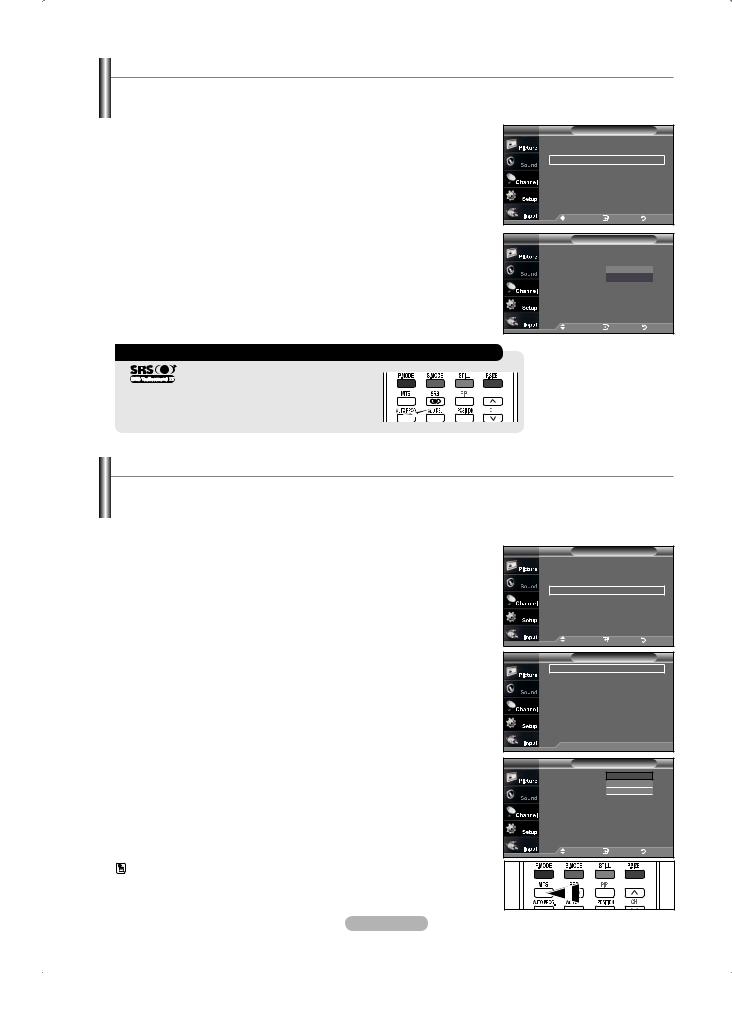
Setting the TruSurround XT
TruSurround XT is a patented SRS technology that solves the problem of playing 5.1 multichannel content over two speakers. TruSurround delivers a compelling, virtual surround sound experience through any two-speaker playback system, including internal television speakers. It is fully compatible with all multichannel formats.
1.Press the MENU button to display the menu.
Press the ▲ or ▼ buttons to select "Sound", then press the ENTER button.
2.Press the ▲ or ▼ buttons to select "SRS TruSurround XT", then press the
ENTER button.
3.Press the ▲ or ▼ buttons to select "On" or "Off", then press the
ENTER button.
Press the EXIT button to exit.
TV |
Sound |
|
Mode |
: Custom |
► |
Equalizer |
|
► |
SRS TruSurround XT : Off |
► |
|
Multi-Track Options |
► |
|
Auto Volume |
: Off |
► |
Internal Mute |
: Off |
► |
Sound Select |
: Main |
► |
Reset |
|
|
Move |
Enter |
Return |
TV |
Sound |
|
Mode |
: Custom |
|
|
||
Equalizer |
|
|
|
|
|
SRS TruSurround XT : Off |
Off |
|
|
||
Multi-Track Options |
|
On |
|
|
|
Auto Volume |
: Off |
|
|
|
|
Internal Mute |
: Off |
|
|
|
|
Sound Select |
: Main |
|
|
|
|
Reset |
|
|
|
|
|
Move |
|
Enter |
Return |
||
TRADEMARK & LABEL LICENSE NOTICE
TruSurround XT, SRS and 
 Symbol are trademarks of SRS Labs, Inc. TruSurround XT technology is incorporated under license from SRS Labs, Inc.
Symbol are trademarks of SRS Labs, Inc. TruSurround XT technology is incorporated under license from SRS Labs, Inc.
Choosing a Multi-Channel Sound (MTS) track - Digital
The digital-TV transmission system is capable of simultaneous transmission of many audio tracks (for example, simultaneous translations of the program into foreign languages). The availability of these additional “multitracks” depends upon the program.
Preferred Language
1.Press the MENU button to display the menu.
Press the ▲ or ▼ buttons to select "Sound", then press the ENTER button.
 Quick way to access the MTS menu: Just press the “MTS” button on the remote control. You can listen in a language other than your chosen language by pressing the MTS button.
Quick way to access the MTS menu: Just press the “MTS” button on the remote control. You can listen in a language other than your chosen language by pressing the MTS button.
2.Press the ▲ or ▼ buttons to select "“Multi-Track Options", then press the ENTER button.
3.Press the ENTER button to select “Preferred Language”.
Press the ▲ or ▼ buttons to choose the language (English, Spanish or French) you want, then press the ENTER button.
Press the EXIT button to exit.
You can listen in a language other than the favorite language by pressing the MTS button on the remote control.
TV |
|
Sound |
|
|
Mode |
: Custom |
► |
|
Equalizer |
|
► |
|
SRS TruSurround XT : Off |
► |
|
|
Multi-Track Options |
► |
|
|
Auto Volume |
: Off |
► |
|
Internal Mute |
: Off |
► |
|
Sound Select |
: Main |
► |
|
Reset |
|
|
|
Move |
Enter |
Return |
TV |
Multi-Track Options |
|
|
Preferred Language : English |
► |
Multi-Track Sound : Stereo |
► |
 Enter
Enter 



 Return
Return
TV |
Multi-Track Options |
|
|
|
Preferred Language : EnglishEnglish |
|
|
|
Multi-Track Sound : StereoSpanish |
|
|
|
|
French |
|
|
Move |
Enter |
Return |
English - 24
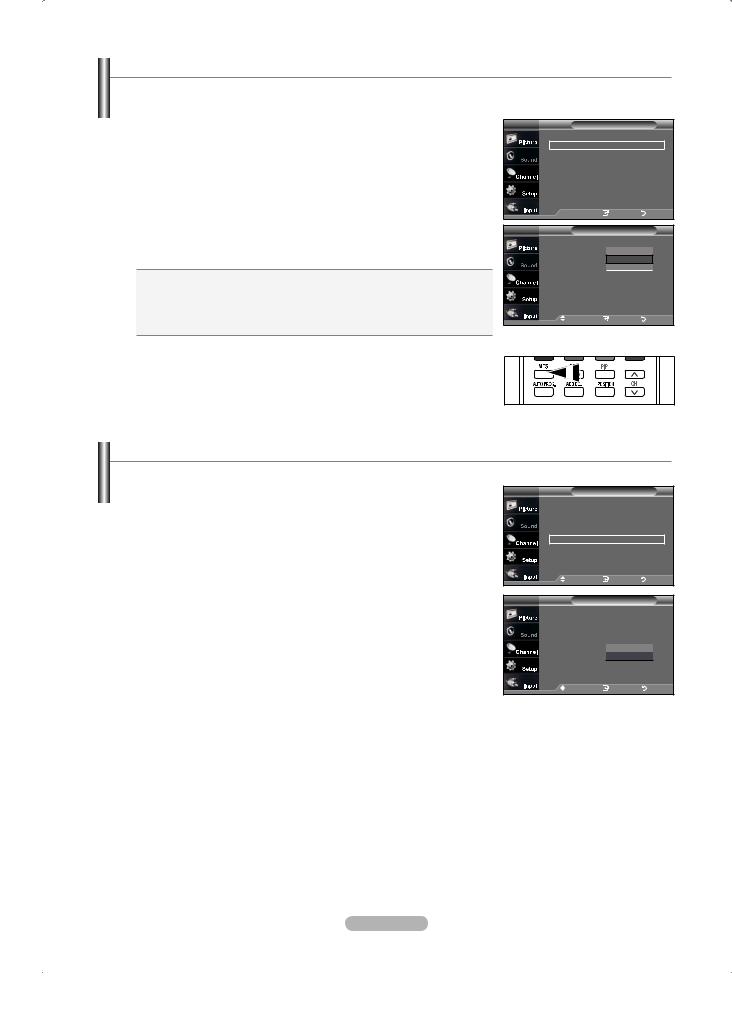
Choosing a Multi-Channel Sound (MTS) track - Analog
Multi-Track Sound
1.Press the MENU button to display the menu.
Press the ▲ or ▼ buttons to select "Sound", then press the ENTER button.
2.Press the ▲ or ▼ buttons to select “Multi-Track Options", then press the ENTER button.
3.Press the ▲ or ▼ buttons to select “Multi-Track Sound”, then press the ENTER button. Press the ▲ or ▼ buttons to select a setting you want, then press the ENTER button.
Press the EXIT button to exit.
•Choose Mono for channels that are broadcasting in mono, or if you are having difficulty receiving a stereo signal.
•Choose Stereo for channels that are broadcasting in stereo.
•Choose SAP to listen to the Separate Audio Program, which is usually a foreign-language translation.
 Press the MTS buttons on the remote control repeatedly to select “Mono”, “Stereo”, or “SAP”.
Press the MTS buttons on the remote control repeatedly to select “Mono”, “Stereo”, or “SAP”.
TV |
Multi-Track Options |
|
|
Preferred Language : English |
► |
|
Multi-Track Sound : Stereo |
► |
|
Enter |
Return |
TV |
Multi-Track Options |
|
|
|
Preferred Language : English |
|
|
|
Multi-Track Sound : StereoMono |
|
|
|
|
Stereo |
|
|
|
SAP |
|
|
Move |
Enter |
Return |
Automatic Volume Control
Reduces the differences in volume level among broadcasters.
1.Press the MENU button to display the menu.
Press the ▲ or ▼ buttons to select "Sound", then press the ENTER button.
2.Press the ▲ or ▼ buttons to select "Auto Volume", then press the ENTER button.
3.Press the ▲ or ▼ buttons to set Auto Volume "On" or "Off" then press the
ENTER button.
Press the EXIT button to exit.
TV |
Sound |
|
Mode |
: Custom |
► |
Equalizer |
|
► |
SRS TruSurround XT : Off |
► |
|
Multi-Track Options |
► |
|
Auto Volume |
: Off |
► |
Internal Mute |
: Off |
► |
Sound Select |
: Main |
► |
Reset |
|
|
Move |
Enter |
Return |
TV |
Sound |
|
Mode |
: Custom |
|
|
|
Equalizer |
|
|
|
|
SRS TruSurround XT : Off |
|
|
||
Multi-Track Options |
|
|
||
Auto Volume |
: OffOff |
|
|
|
|
|
On |
|
|
Internal Mute |
: |
Off |
|
|
Sound Select |
: Main |
|
|
|
Reset |
|
|
|
|
Move |
|
Enter |
Return |
|
English - 25

Selecting the Internal Mute
Sound output from the TV speakers is muted.
1.Press the MENU button to display the menu.
Press the ▲ or ▼ buttons to select "Sound", then press the ENTER button.
2.Press the ▲ or ▼ buttons to select "Internal Mute", then press the ENTER button.
3.Press the ▲ or ▼ buttons to select “On”, then press the ENTER button.
Press the EXIT button to exit.
 When Internal Mute is set to “On”, Sound menus except Multi-track Options cannot be adjusted.
When Internal Mute is set to “On”, Sound menus except Multi-track Options cannot be adjusted.
 The VOL
The VOL , VOL
, VOL and MUTE buttons do not operate when the Internal Mute is set to On.
and MUTE buttons do not operate when the Internal Mute is set to On.
TV |
Sound |
|
Mode |
: Custom |
► |
Equalizer |
|
► |
SRS TruSurround XT : Off |
► |
|
Multi-Track Options |
► |
|
Auto Volume |
: Off |
► |
Internal Mute |
: Off |
► |
Sound Select |
: Main |
► |
Reset |
|
|
Move |
Enter |
Return |
TV |
Sound |
|
Mode |
: Custom |
|
|
|
Equalizer |
|
|
|
|
SRS TruSurround XT : Off |
|
|
||
Multi-Track Options |
|
|
||
Auto Volume |
: Off |
|
|
|
Internal Mute |
: OffOff |
|
|
|
|
|
On |
|
|
Sound Select |
: |
Main |
|
|
Reset |
|
|
|
|
Move |
|
Enter |
Return |
|
|
TV's Internal Speakers |
Audio Out (Optical, L/R Out) to Sound System |
||||
|
|
|
|
|
|
|
|
RF |
AV, S-Video |
Component, PC, HDMI |
RF |
AV, S-Video |
Component, PC |
|
|
|
|
|
|
|
Internal Mute Off |
Speaker Output |
Speaker Output |
Speaker Output |
Sound Output |
Sound Output |
Sound Output |
|
|
|
|
|
|
|
Internal Mute On |
Mute |
Mute |
Mute |
Sound Output |
Sound Output |
Sound Output |
|
|
|
|
|
|
|
Video No Signal |
Mute |
Mute |
Mute |
Mute |
Mute |
Mute |
|
|
|
|
|
|
|
 When “Internal mute” is set to “On”, Sound menus except “Multi-Track Options” cannot be adjusted.
When “Internal mute” is set to “On”, Sound menus except “Multi-Track Options” cannot be adjusted.
Listening to the Sound of the Sub (PIP) Picture
When the PIP feature is activated, you can listen to the sound of the sub (PIP) picture.
1.Press the MENU button to display the menu.
Press the ▲ or ▼ buttons to select "Sound", then press the ENTER button.
2.Press the ▲ or ▼ buttons to select "Sound Select”, then press the ENTER button.
3.Press the ▲ or ▼ buttons to select “Main” or “Sub”, then press the ENTER button.
Press the EXIT button to exit.
•Main: Used to listen to the sound of the main picture.
•Sub: Used to listen to the sound of the sub picture.
 You can select this option when “PIP” is set to “On”.
You can select this option when “PIP” is set to “On”.
TV |
Sound |
|
Mode |
: Custom |
► |
Equalizer |
|
► |
SRS TruSurround XT : Off |
► |
|
Multi-Track Options |
► |
|
Auto Volume |
: Off |
► |
Internal Mute |
: Off |
► |
Sound Select |
: Main |
► |
Reset |
|
|
Move |
Enter |
Return |
TV |
Sound |
|
Mode |
: Custom |
|
|
|
Equalizer |
|
|
|
|
SRS TruSurround XT : Off |
|
|
||
Multi-Track Options |
|
|
||
Auto Volume |
: Off |
|
|
|
Internal Mute |
: OffMain |
|
|
|
Sound Select |
: |
MainSub |
|
|
Reset |
|
|
|
|
Move |
|
Enter |
Return |
|
English - 26
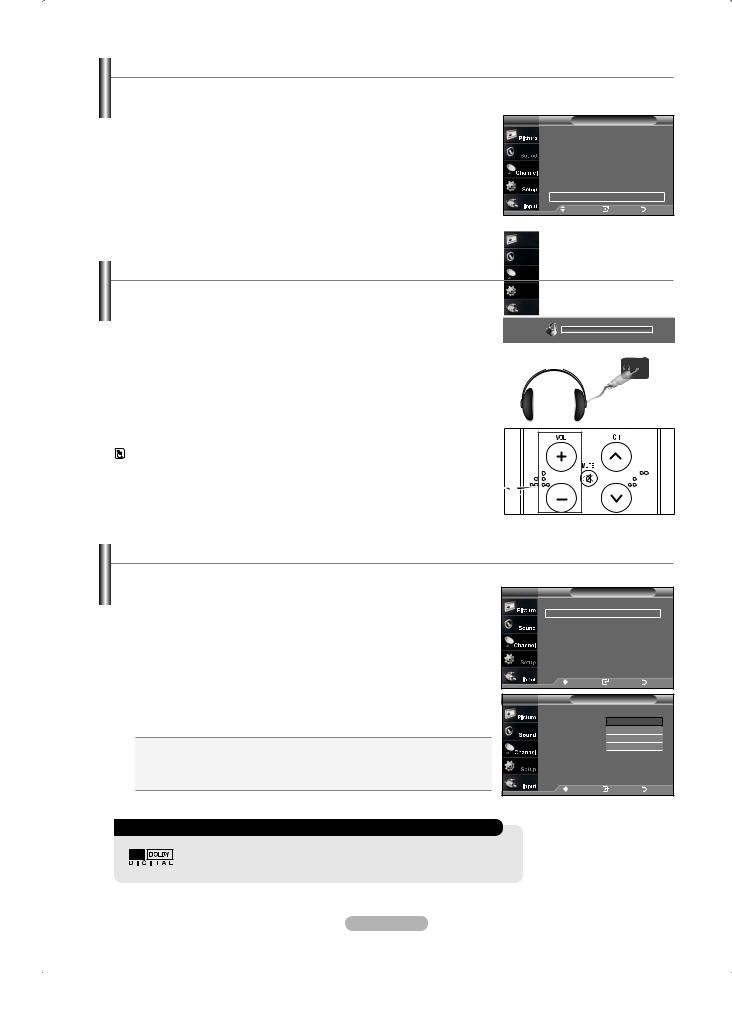
Resetting the Sound Settings to the Factory Defaults
If Game Mode is On, the Reset Sound function is activated. Selecting the Reset function resets the equalizer setting to the factory defaults.
1.Press the MENU button to display the menu.
Press the ▲ or ▼ buttons to select "Sound", then press the ENTER button.
2.Press the ▲ or ▼ buttons to select "Reset”, then press the ENTER button.
Press the EXIT button to exit.
TV |
Sound |
|
Mode |
: Custom |
► |
Equalizer |
|
► |
SRS TruSurround XT : Off |
► |
|
Multi-Track Options |
► |
|
Auto Volume |
: Off |
► |
Internal Mute |
: Off |
► |
Sound Select |
: Main |
► |
Reset |
|
|
Move |
Enter |
Return |
Connecting Headphones
You can connect a set of headphones to your set if you wish to watch a TV program without disturbing the other people in the room.
 When you insert the head set jack into the corresponding port, you can operate only “Multi track option” in Sound menu.
When you insert the head set jack into the corresponding port, you can operate only “Multi track option” in Sound menu.
 Prolonged use of headphones at a high volume may damage your hearing.
Prolonged use of headphones at a high volume may damage your hearing.
 You will not receive sound from the speakers when you connect headphones to the system.
You will not receive sound from the speakers when you connect headphones to the system.
 The headphone volume and TV volume are adjusted differently.
The headphone volume and TV volume are adjusted differently.
Press the VOL button on the remote control repeatedly to select one of the sound settings.
Setting the On/Off Melody
A melody sound can be set to come on when the TV is powered On or Off.
1.Press the MENU button to display the menu.
Press the ▲ or ▼ buttons to select "Setup", then press the ENTER button.
2.Press the ▲ or ▼ buttons to select "Melody", then press the ENTER button.
3.Press the ▲ or ▼ buttons to select "Off", "Low", "Medium", "High" then press the
ENTER button.
Off: Turns off the melody function.
Low: Sets the melody volume to low.
Medium: Sets the melody volume to medium.
High: Sets the melody volume to high.
Press the EXIT button to exit.
DOLBY DIGITAL
TV |
Setup |
|
▲More |
|
|
Melody |
: Off |
► |
PC |
|
► |
HDMI Black Level |
: Normal |
► |
Film Mode |
: Off |
► |
PIP |
|
► |
Function Help |
: On |
► |
▼More |
|
|
Move |
Enter |
Return |
TV |
Setup |
|
▲More |
|
|
Melody |
: Off |
► |
PC |
Off |
|
Low |
|
|
HDMI Black Level |
Medium |
|
Film Mode |
High |
|
PIP |
|
|
Function Help |
: On |
|
▼More |
|
|
Move |
Enter |
Return |
Manufactured under license from Dolby Laboratories.
“Dolby” and the double-D symbol are trademarks of Dolby Laboratories.
English - 27
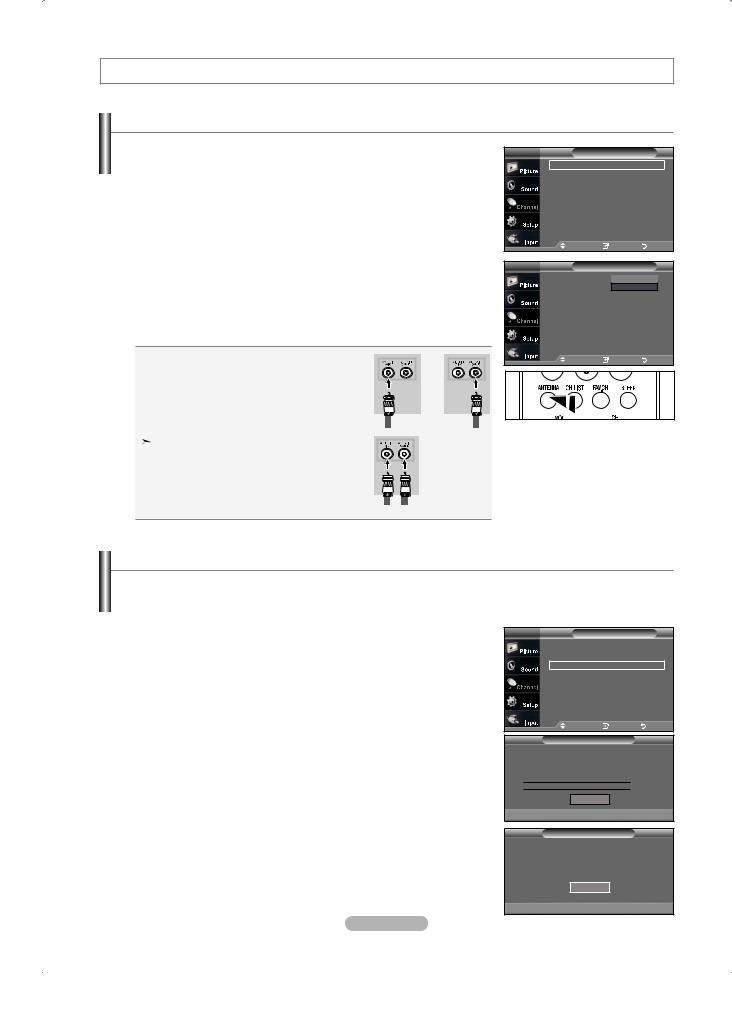
Channel Control
Selecting the Antenna
1.Press the MENU button to display the menu.
Press the ▲ or ▼ buttons to select "Channel", then press the ENTER button.
2.Press the ENTER button to select “Antenna”.
Press the ▲ or ▼ buttons to select “Air” or “Cable”, then press the ENTER button.
Press the EXIT button to exit.
 Press the ANTENNA button on the remote control.
Press the ANTENNA button on the remote control.
 If the antenna is connected to ANT 1 IN (AIR), select “Air” and if it is connected to ANT 2 IN (CABLE), select “Cable”.
If the antenna is connected to ANT 1 IN (AIR), select “Air” and if it is connected to ANT 2 IN (CABLE), select “Cable”.
If both ANT 1 IN (AIR) and ANT 2 IN (CABLE) |
or |
are connected, select the antenna input you want. |
|
If the antenna input is not selected properly, noise |
|
may appear on the screen. |
|
TV |
Channel |
|
Antenna |
: Air |
► |
Auto Program |
|
► |
Clear Scrambled Channel |
► |
|
Channel List |
|
► |
Name |
|
► |
Fine Tune |
|
► |
Signal Strength |
|
► |
LNA |
: On |
► |
Move |
Enter |
Return |
TV |
Channel |
|
Antenna |
: AirAir |
|
Auto Program |
Cable |
|
Clear Scrambled Channel |
|
|
Channel List |
|
|
Name |
|
|
Fine Tune |
|
|
Signal Strength |
|
|
LNA |
: On |
|
Move |
Enter |
Return |
Clearing Scrambled Channels - Digital
The Clear Scrambled Channel function is used to filter out scrambled channels afterAuto Program is completed.
It removes the scrambled channels from the list by tuning the digital cable channels. This process may take up to 20~30 minutes.
1.Press the MENU button to display the menu.
Press the ▲ or ▼ buttons to select "Channel", then press the ENTER button.
2.Press the ▲ or ▼ button to select "Clear Scrambled Channel", then press the
ENTER button. It searches scrambled channels, which are to be removed from the list.
 To stop searching scrambled channels;
To stop searching scrambled channels;
Press the ENTER button to select Stop
Press the ◄ button to select Yes, then press the ENTER button.
3.When the scrambled channel searching is completed, press the ENTER button. Press the EXIT button to exit.
TV |
Channel |
|
Antenna |
: Cable |
► |
Auto Program |
|
► |
Clear Scrambled Channel |
► |
|
Channel List |
|
► |
Name |
|
► |
Fine Tune |
|
► |
Signal Strength |
|
► |
LNA |
: On |
► |
Move |
Enter |
Return |
Clear Scrambled Channel
Removing scrambled channel.
DTV Cable 3-1

 50%
50%
Stop
 Enter
Enter 
 Return
Return
Clear Scrambled ChannelDTV Cable
Scrambled Channel Searching is completed60%. 0 Channels are deleted.
OK
 Return
Return
English - 28
